These Fluffy Japanese Soufflé Pancakes are like eating soft and cottony clouds! Top them with homemade whipped cream and fresh berries for an extra delicious treat. I’ll teach you my best tips so you can make them perfectly at home.
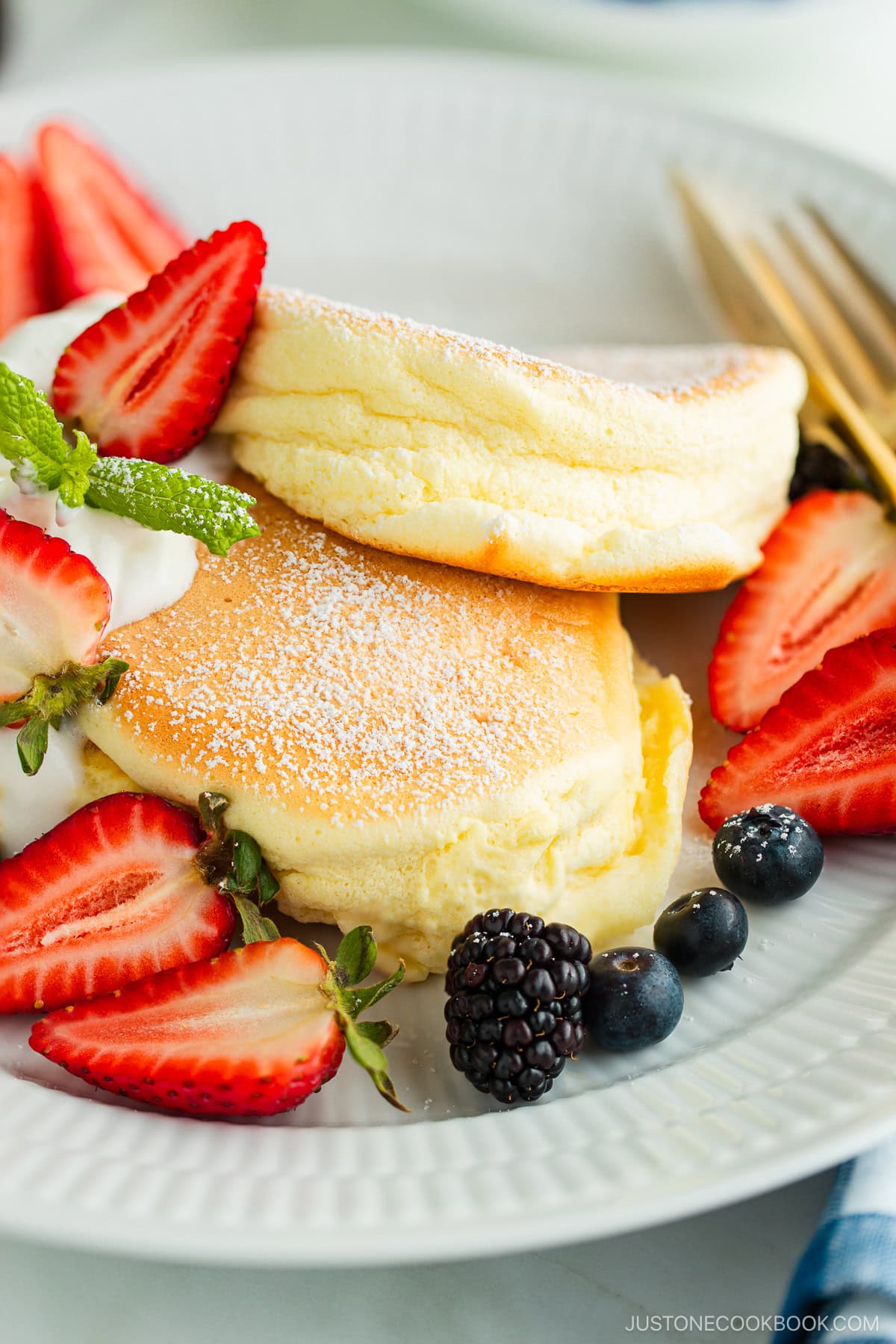
The Japanese take pancakes to new heights with Fluffy Japanese Soufflé Pancakes (スフレパンケーキ). Tall, soft, and super airy, these special pancakes are a must-try recipe for your weekend breakfast. I’ll share my techniques for how to whip up an airy batter and use low-and-slow cooking to make the best soufflé pancakes at home!
If you’re craving more delicious breakfast recipes, try my Matcha Soufflé Pancakes, Shokupan (Japanese Milk Bread), and Steamed Cake (Mushi-pan) next!
Table of Contents
Why I Love This Recipe
- So pillowy soft and delicious! – These delicate pancakes are extra fluffy compared to regular flapjacks thanks to the air bubbles whipped into the egg whites. I love the fizzy sound of air bubbles escaping when I cut into them!
- A comforting weekend treat – Pancakes are the happiest comfort food. This recipe is the perfect cooking project for a leisurely weekend brunch or a special occasion—think birthdays, anniversaries, Mother’s Day, or Valentine’s Day.
- Works with creative toppings – I love serving these with fresh whipped cream and berries, but you can get creative with your favorite syrups, sauces, fruit, and other toppings.
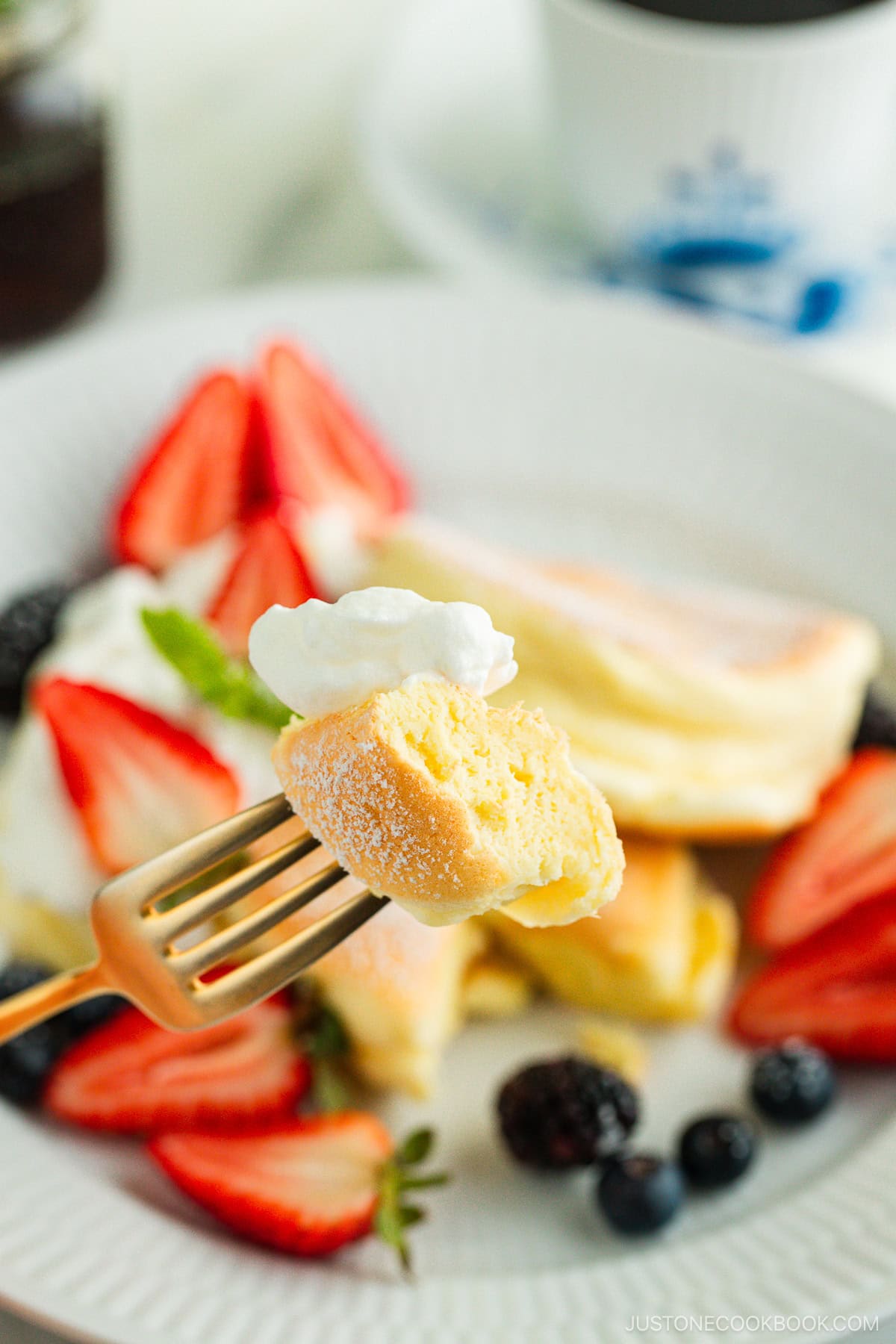
Ingredients for Japanese Soufflé Pancakes
- large eggs
- cake flour
- whole milk
- sugar
- vanilla extract
- baking powder
- neutral oil – for greasing the pan
- water – for steaming
- Toppings:
- confectioners’ sugar
- maple syrup
- heavy (whipping) cream and sugar – optional, for the fresh whipped cream; see how I make it in the recipe below
- fresh berries – optional; I love using strawberries and blueberries
Find the printable recipe with measurements below.
Jump to RecipeSubstitutions
- Cake flour – If you don’t have cake flour on hand, you can make it at home! For every 1 cup of all-purpose flour, remove 2 Tbsp of it and replace with 2 Tbsp of cornstarch. Sift together 3–5 times and it’s ready to use.
Key Equipment
- Hand mixer or stand mixer with a balloon whisk attachment (to whip the egg whites)
- Hand whisk
- Large nonstick frying pan with lid
- Offset spatula
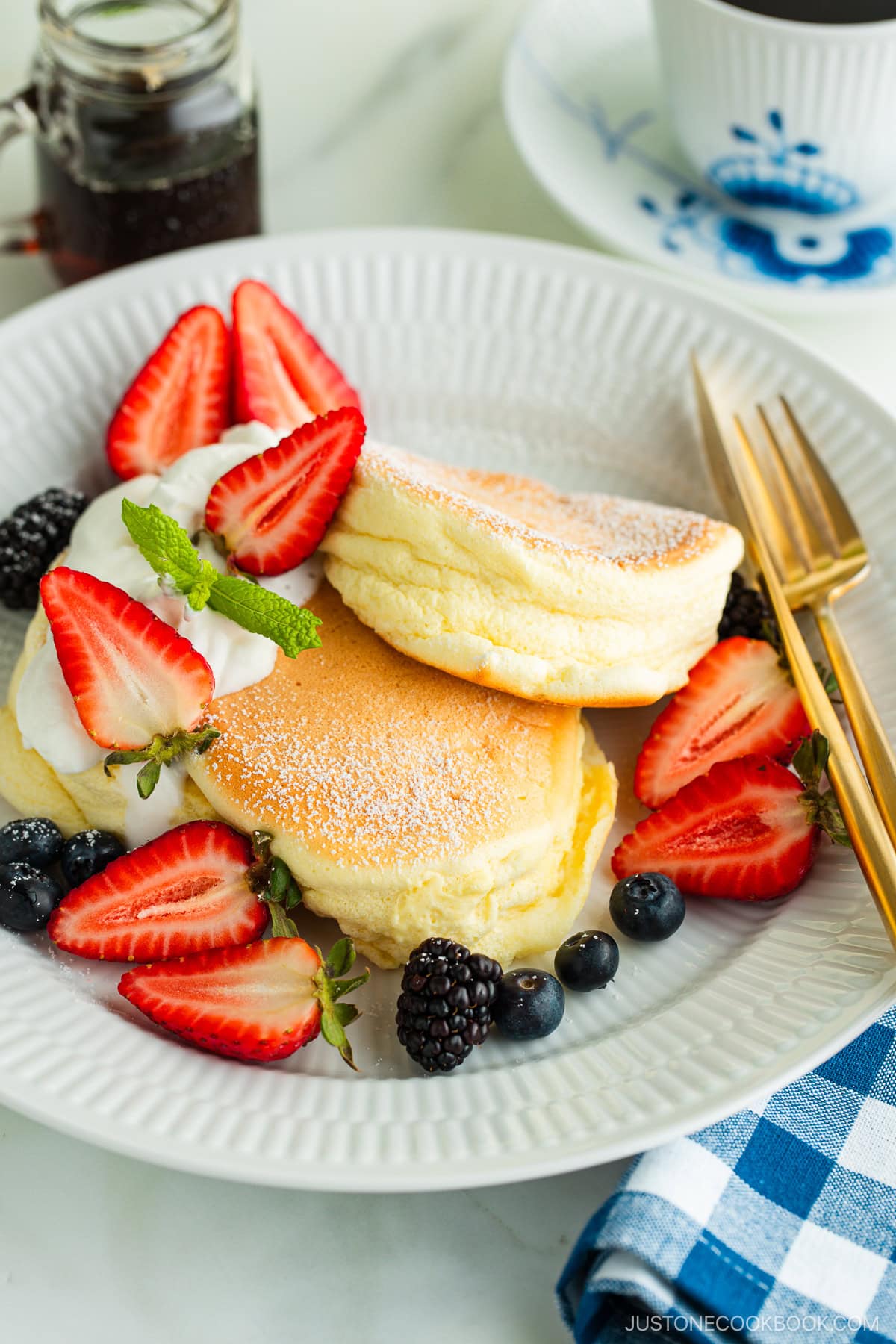
How To Make Soufflé Pancakes
Preparation
Step 1 – Mix the batter. Separate the egg whites and yolks into two bowls and put the bowl of whites in the freezer for 15 minutes. Whisk the yolks, milk, and vanilla extract with a mixer until thick and frothy. Sift the flour and baking powder into the liquid mixture and whisk by hand to combine; do not overmix.
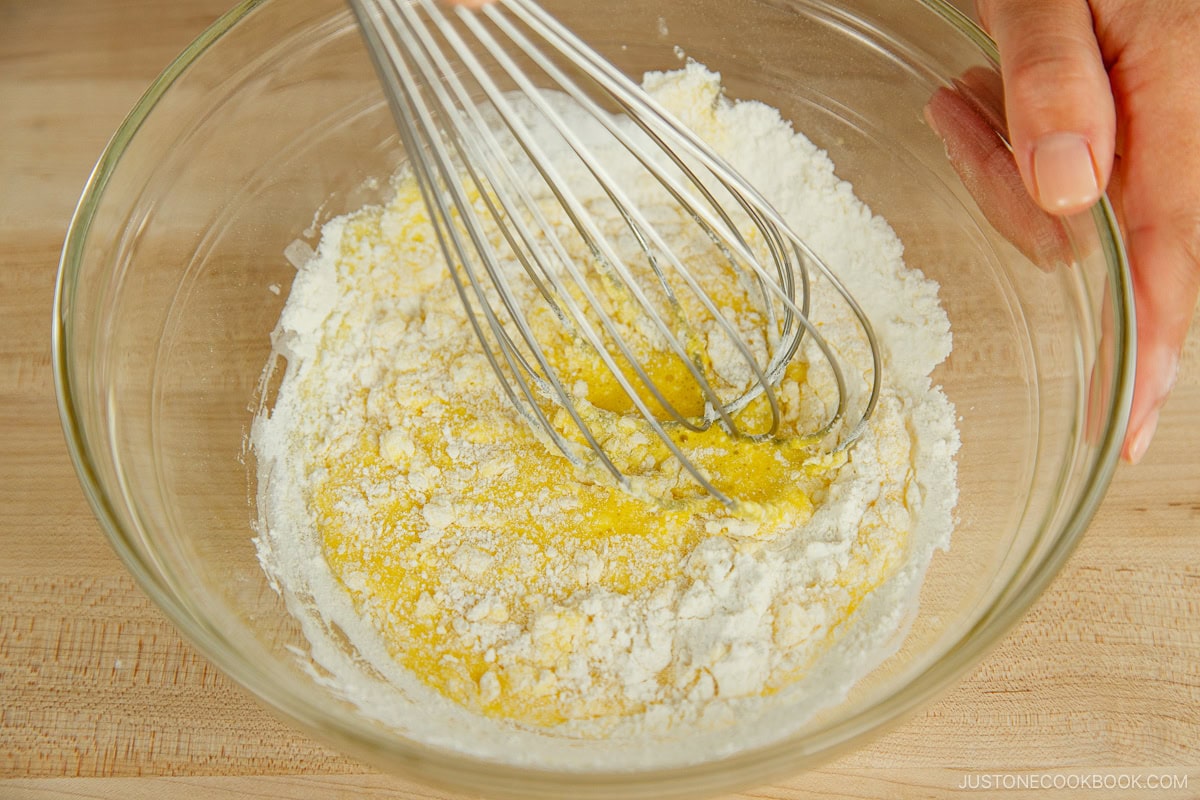
Step 2 – Make the meringue and preheat the pan. Beat the half-frozen egg whites until frothy and opaque. Gradually add the sugar while beating at high speed until stiff peaks form. Look for meringue that holds a peak and has a tip that folds over. Start preheating a large, nonstick frying pan to 300ºF (150ºC) on the lowest heat and lightly grease it with oil.
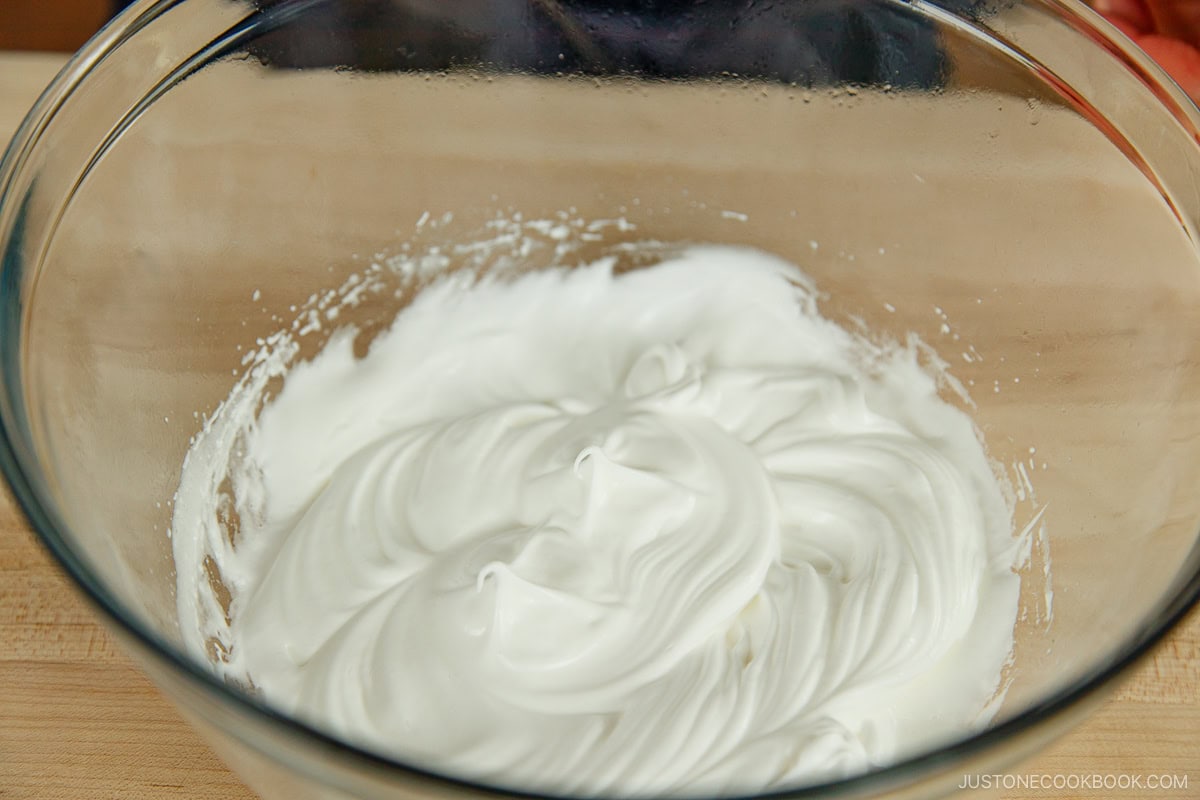
Step 3 – Gently fold the meringue into the batter by hand. Use a hand whisk to fold in the whipped egg whites, one-third at a time. Gently incorporate without breaking the air bubbles. Mix until well combined and homogeneous.
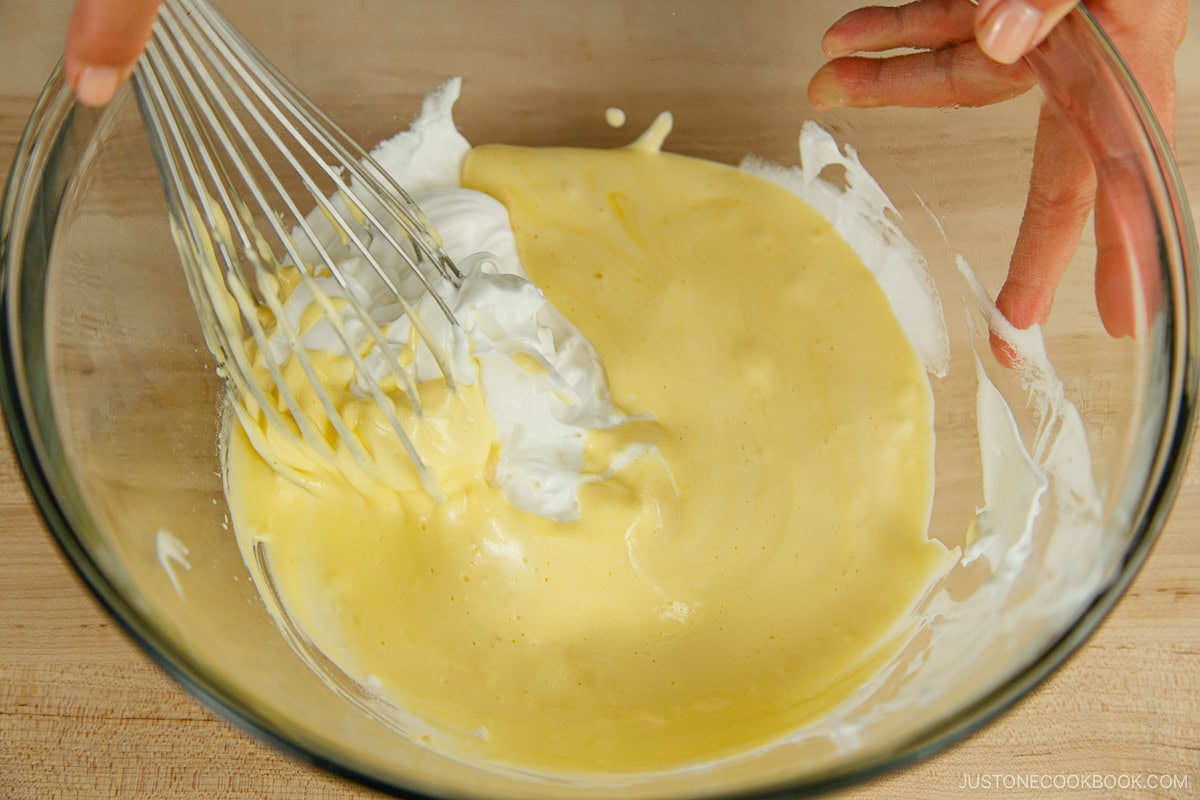
Cooking
Step 4 – Stack three scoops of batter for each pancake. Keep your preheated frying pan at 300ºF (150ºC) over low heat at all times. For the first pancake, place one small scoop of batter in the pan in a tall mound. Then, stack a second scoop on top. Repeat to make the other two pancakes. Then, mound a third scoop onto each, keeping the batter piled high.
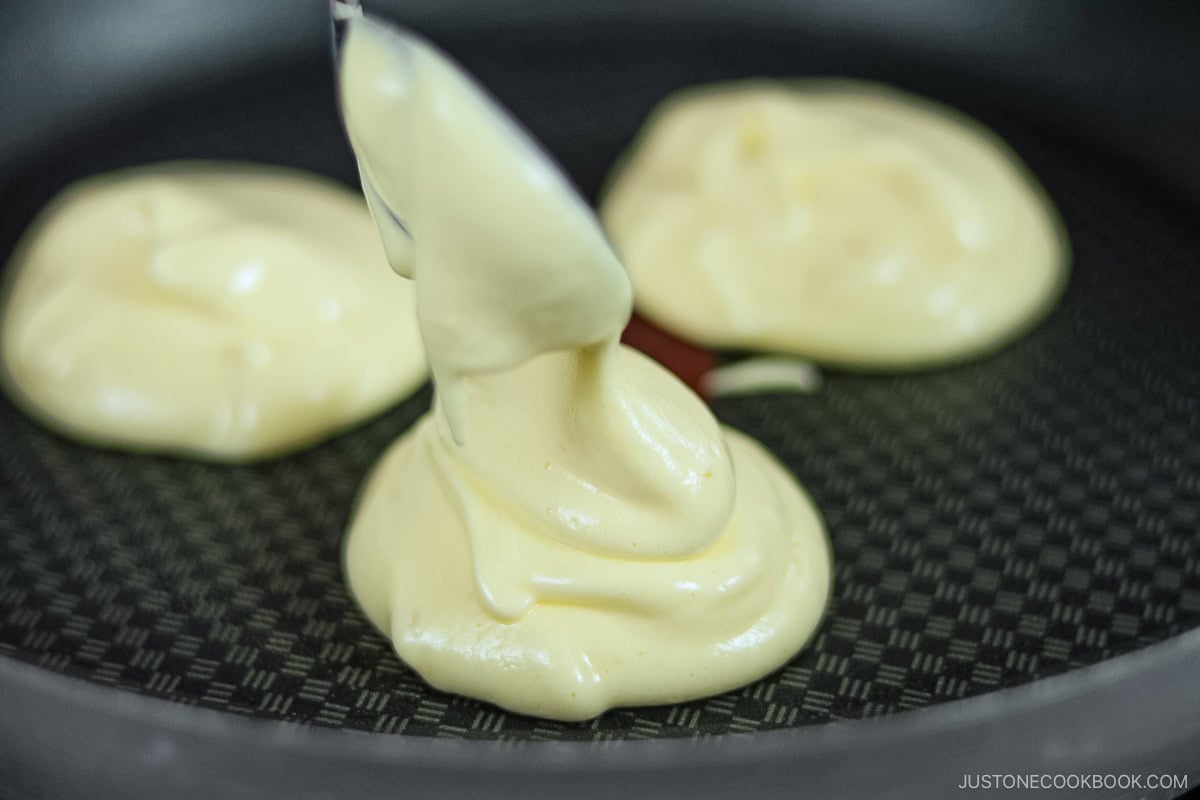
Step 5 – Add water, cover, and set a timer for 6–7 minutes. A splash of water in the pan creates steam and covering with a lid locks in the moisture. After 2 minutes, add a final scoop of batter to each pancake. Cover and keep cooking.
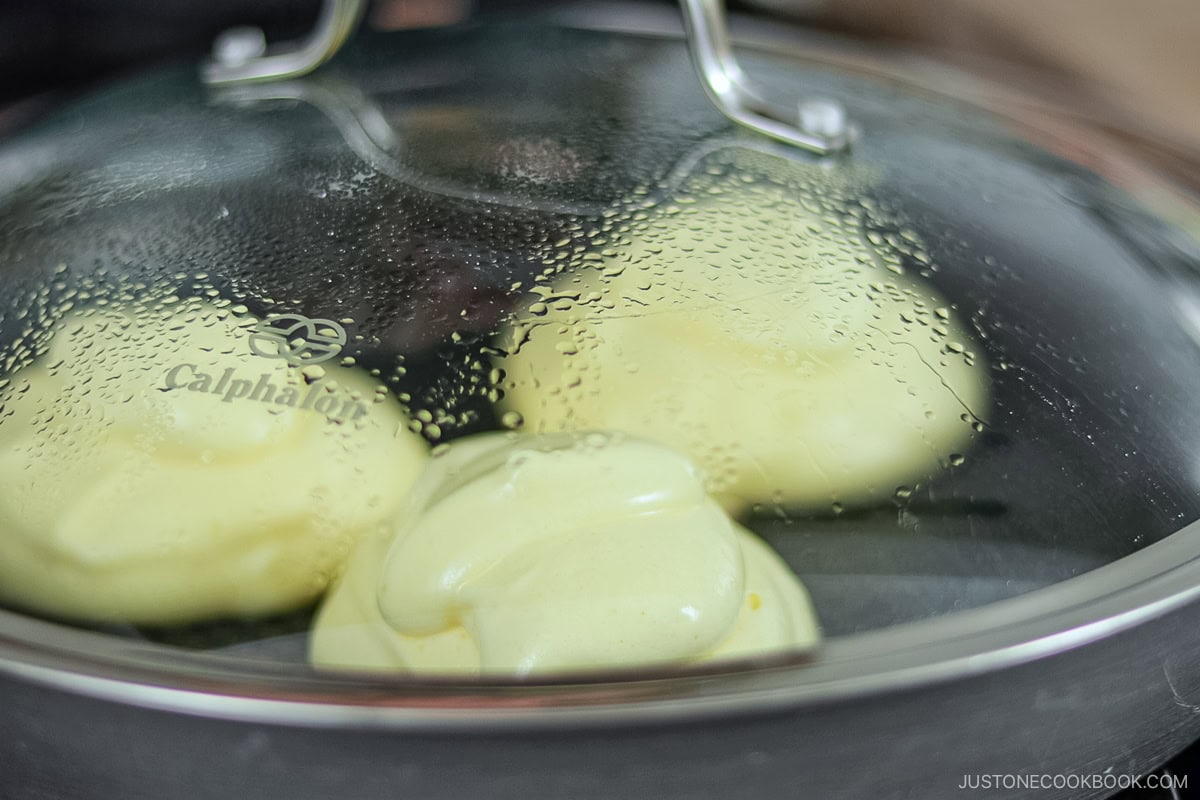
Step 6 – Flip over, add more water, and cover to finish cooking. When the timer goes off, use an offset spatula to very gently flip the pancakes with a “rolling over” motion. Add another splash of water and cover the pan. Set the timer for 4–5 minutes and cook until the other side is nicely browned.
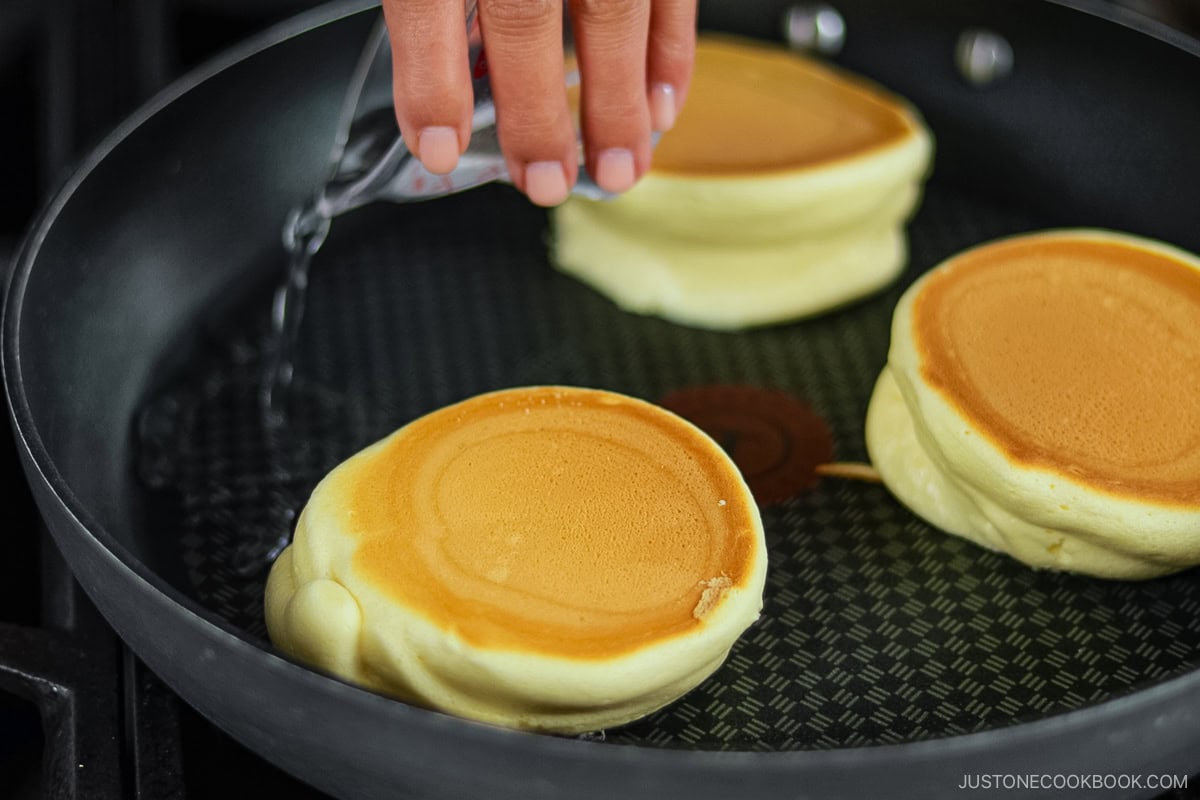
Step 7 – Serve! Transfer to individual plates. Dust with confectioners’ sugar and drizzle with maple syrup. I love topping them with fresh whipped cream and fresh berries. Enjoy!
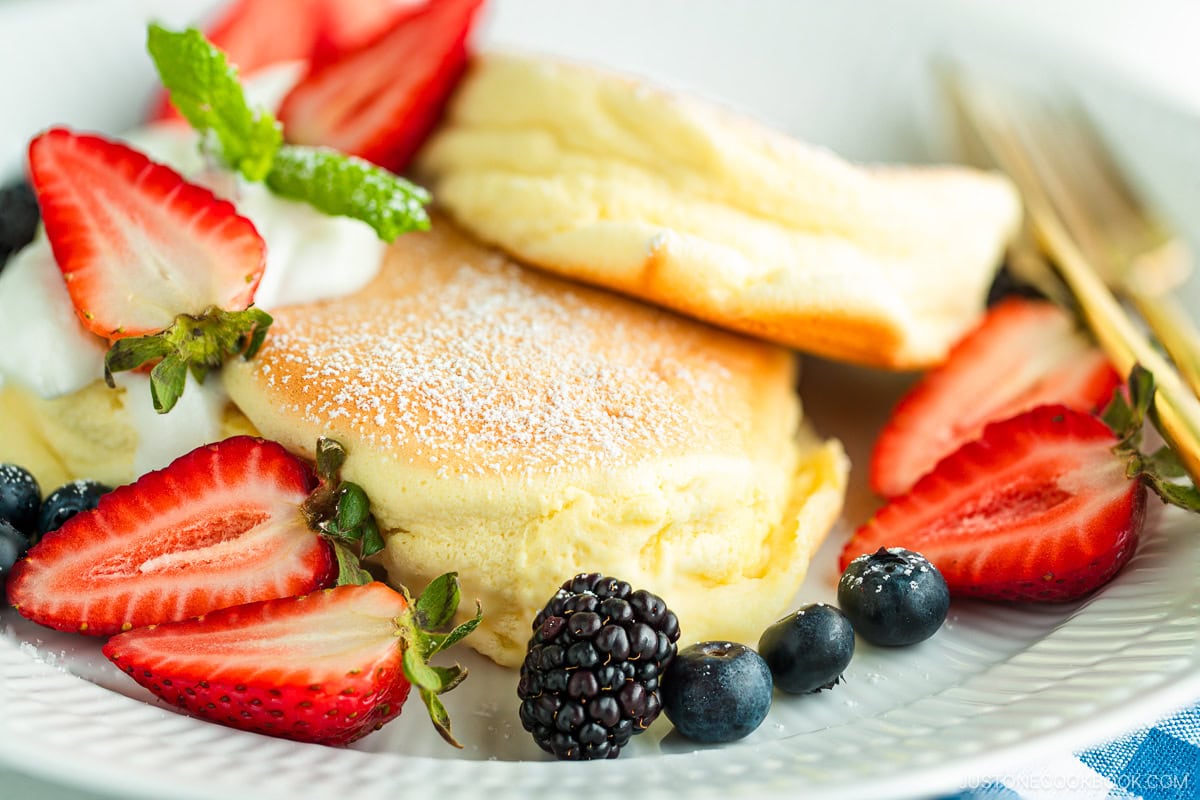
Nami’s Recipe Tips
- Beat the egg whites to stiff peaks – When you lift up the whisk, the egg whites should stand straight up while the very tip folds over, like it’s taking a bow. Making meringue takes practice, but I promise it gets easier once you know how to achieve the right consistency.
- Preheat the pan thoroughly and evenly – Even heating is crucial for the pancakes to cook through. It also gives you full control over the cooking time and final result. To prevent hot spots, I suggest preheating your pan slowly on the lowest setting.
- Pile the batter high – The key to making lofty pancakes is to add a new pile on top of the batter already in the pan once the pancake starts to form.
- Cover and cook it steady, slow, and low – This is the key point for properly cooking the interior of these thick pancakes. If you use higher heat, they may look done, but the inside will be raw and the pancakes will deflate once the temperature drops. To lock in the heat and moisture while cooking, be sure to cover the pan with a lid.
- Add water to create steam – At two different times, I add 1 Tbsp of water to the empty spaces in the frying pan to create a moist cooking environment.
- Flip very gently with a “rolling over” motion – I pull the pancake slightly with an offset spatula to create an empty space, then gently roll it over. If it’s stuck, give it time to firm up before you try to flip it. Handle with care to avoid cracking or deflating them.
- Mix and cook only one batch of batter at a time. Otherwise, the batter will deflate if left to sit for too long. To make two or more servings, you will need multiple nonstick frying pans on the stove. Alternatively, you can use an electric or cast iron griddle with a lid.
Variations and Customizations
- Make it with matcha. If you’re a fan of Japanese green tea powder, add matcha to the batter! It gives the pancakes a wonderful green hue and flavor boost. You can see how I make it in my Matcha Soufflé Pancakes recipe.
- Switch up the toppings. The sky’s the limit when it comes to toppings! While berries are classic, you can try peaches, mangoes, or whatever is ripe and in-season. You could also add a dollop of jam, fruit preserves, or lemon curd. Instead of maple syrup, try drizzling kuromitsu (Japanese black sugar syrup), chocolate sauce, or strawberry sauce on top. Chocolate chips are another popular choice.
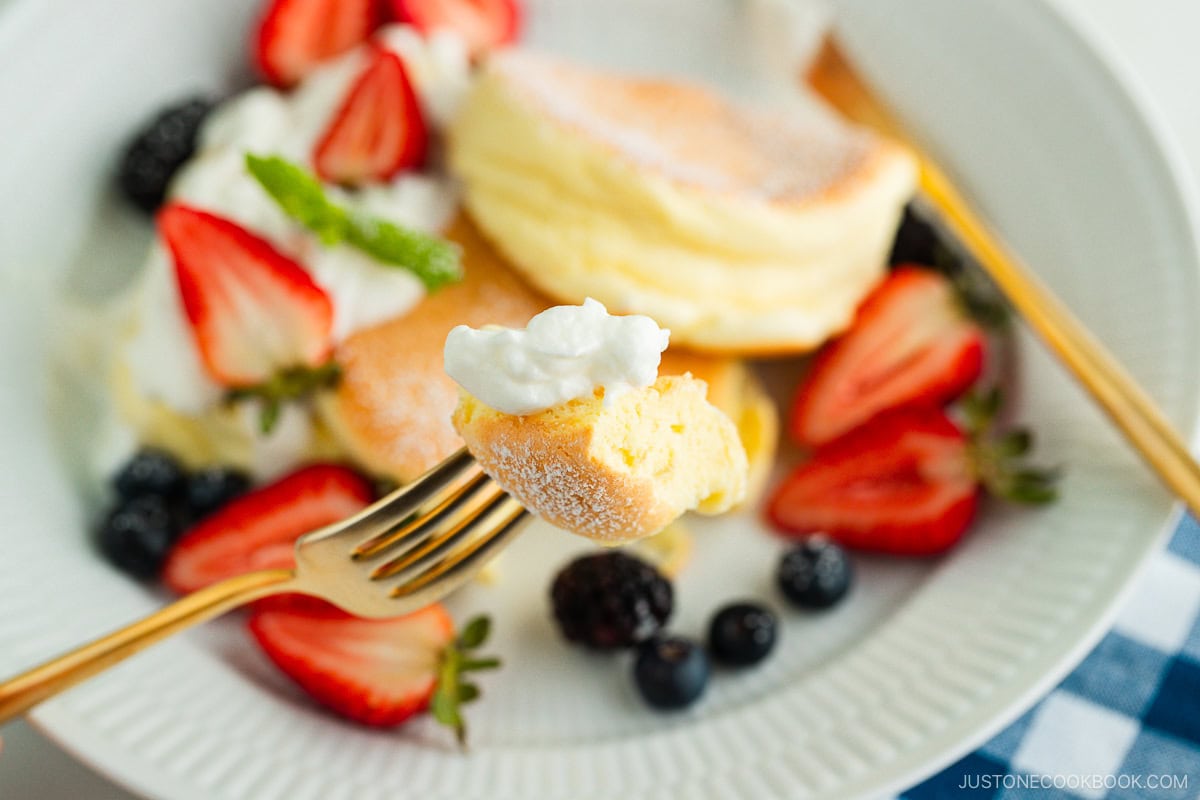
What To Serve with Japanese Soufflé Pancakes
I love to serve these pancakes with a delicious morning drink:
- Hot beverage: Matcha Latte is creamy, earthy, and so easy to make at home.
- Iced beverage: With a rich aroma, Iced Hojicha Latte is a popular cafe drink in Japan!
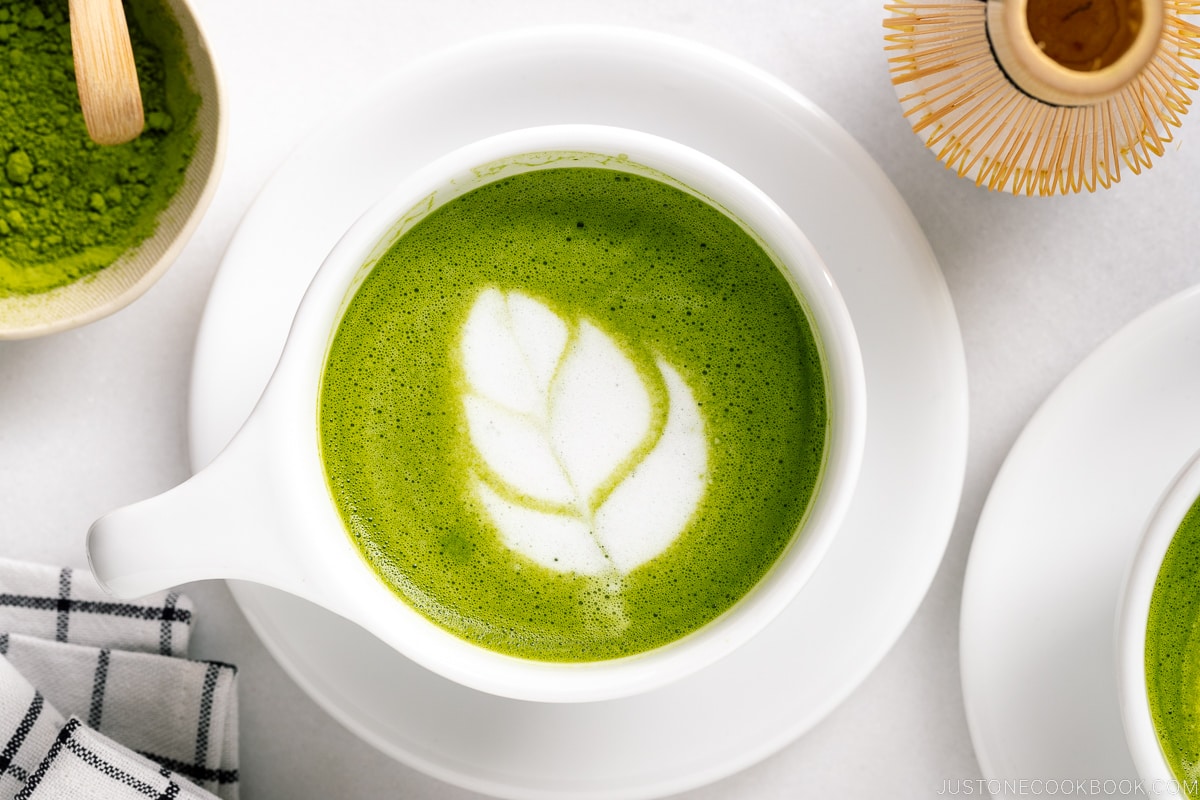
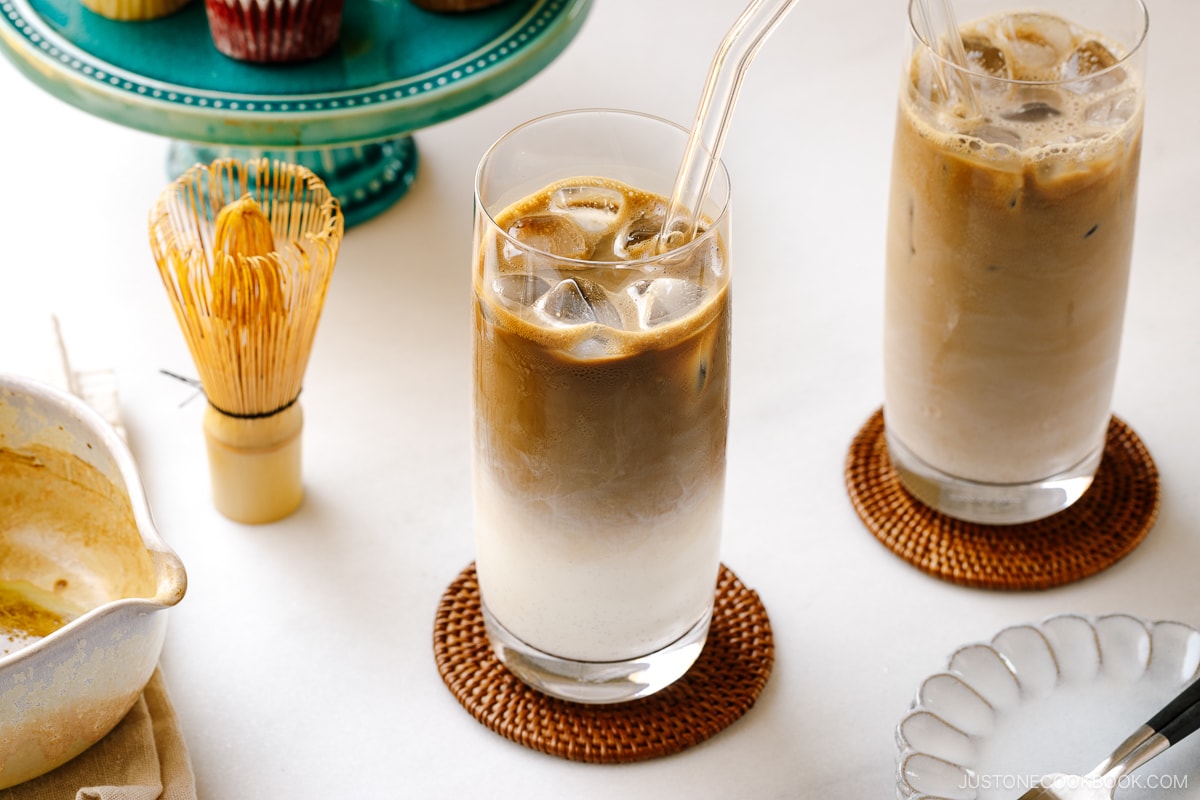
Storage Tips
To store: For the fluffiest texture, I recommend making these soufflé pancakes just before serving. If you have leftovers, transfer them to an airtight container and store in the refrigerator for up to 2 days. I don’t recommend freezing them.
Frequently Asked Questions
Properly cooked soufflé pancakes will have a solid structure and height that will hold for 10–15 minutes as long as they are warm (just like hot air balloons). If they collapse when you move them to a plate, there are two possible reasons why.
First, you may have underbeaten or overbeaten the egg whites. You want to achieve stiff peaks to create air bubbles that give structure to the pancake. Without them, the pancake will deflate as soon as the temperature drops. For stiff peaks, look for egg whites that stand straight up and folds over at the very tip when you lift the whisk.
Second, the stove’s heat may have been too strong. Just because the pancake is nicely browned, it doesn’t mean it’s done. The inside might still be raw and undercooked. If you move it out of the pan before the interior is cooked, the air will deflate. To avoid this, cover the pan and cook on the lowest heat setting. These tall and thick pancakes will take much longer to cook through than a standard pancake.
To make two or more servings, you will need multiple nonstick frying pans on the stove. Alternatively, you can use an electric or cast iron griddle with a lid. At soufflé pancake restaurants in Japan, they use multiple electric griddles with a lid. The staff would usually tell you the soufflé pancakes will take at least 20 minutes to make.
I’ve demonstrated this recipe using white granulated sugar, but I often make it with organic cane sugar. You can use the sugar in your pantry but it may alter the flavor.
More Breakfast and Brunch Recipes
If you love this recipe for Fluffy Japanese Soufflé Pancakes, you’re in for a treat with these other irresistible breakfast and brunch recipes that are popular in Japan.
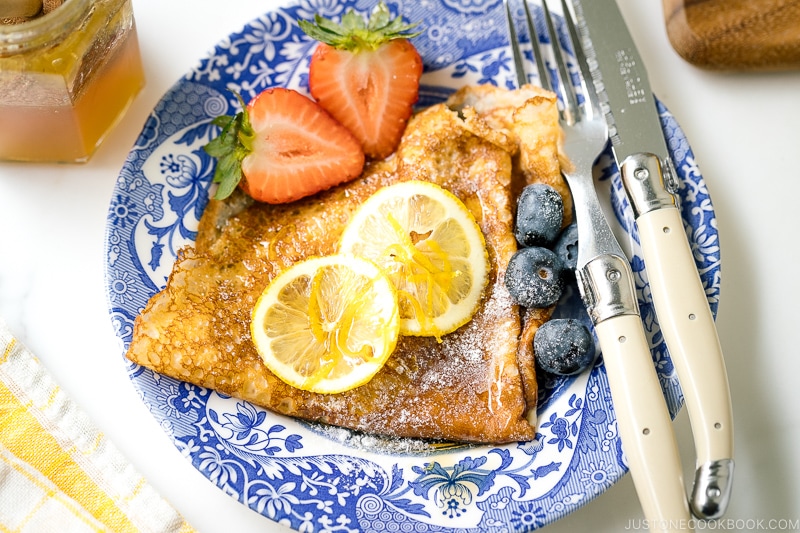
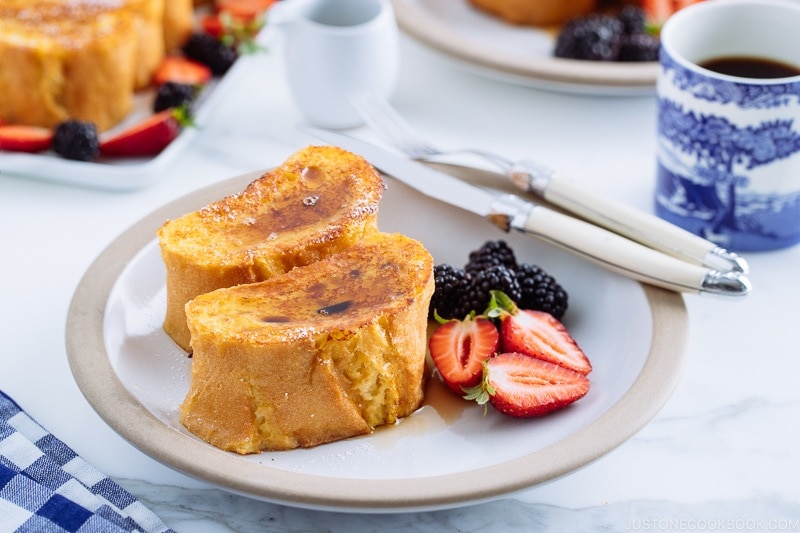
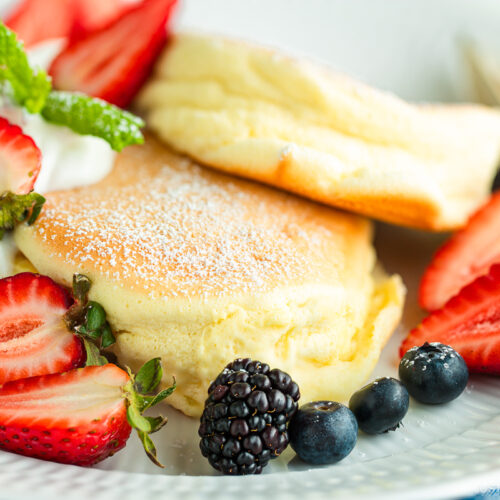
Fluffy Japanese Soufflé Pancakes
Video
Ingredients
- 2 large eggs (50 g each w/o shell)
- 1½ Tbsp whole milk (I haven‘t tried reduced-fat, low-fat, nonfat, or plant-based milk for this recipe as I believe the batter will be too thin to make souffle pancakes)
- ¼ tsp pure vanilla extract
- ¼ cup cake flour (weigh your flour or use the “fluff and sprinkle“ method and level it off; you can make homemade cake flour)
- ½ tsp baking powder
- 2 Tbsp sugar
- 1 Tbsp neutral oil (for greasing the pan)
- 2 Tbsp water (for steaming)
For the Fresh Whipped Cream (optional)
- ½ cup heavy (whipping) cream
- 1½ Tbsp sugar (add more if you like it sweeter)
For the Toppings
- 1 Tbsp confectioners’ sugar
- fresh berries (strawberries, blueberries, etc.)
- maple syrup
Instructions
Before You Start…
- Gather all the ingredients. I highly encourage you to use metric measurements using a kitchen scale for this recipe. Click on the Metric button at the top of the recipe to convert the ingredient measurements to metric. You will also need a 12-inch nonstick frying pan (large enough to cook 3 pancakes at the same time) with a lid. It‘s also nice to have an infrared thermometer gun to check the temperature of the frying pan.
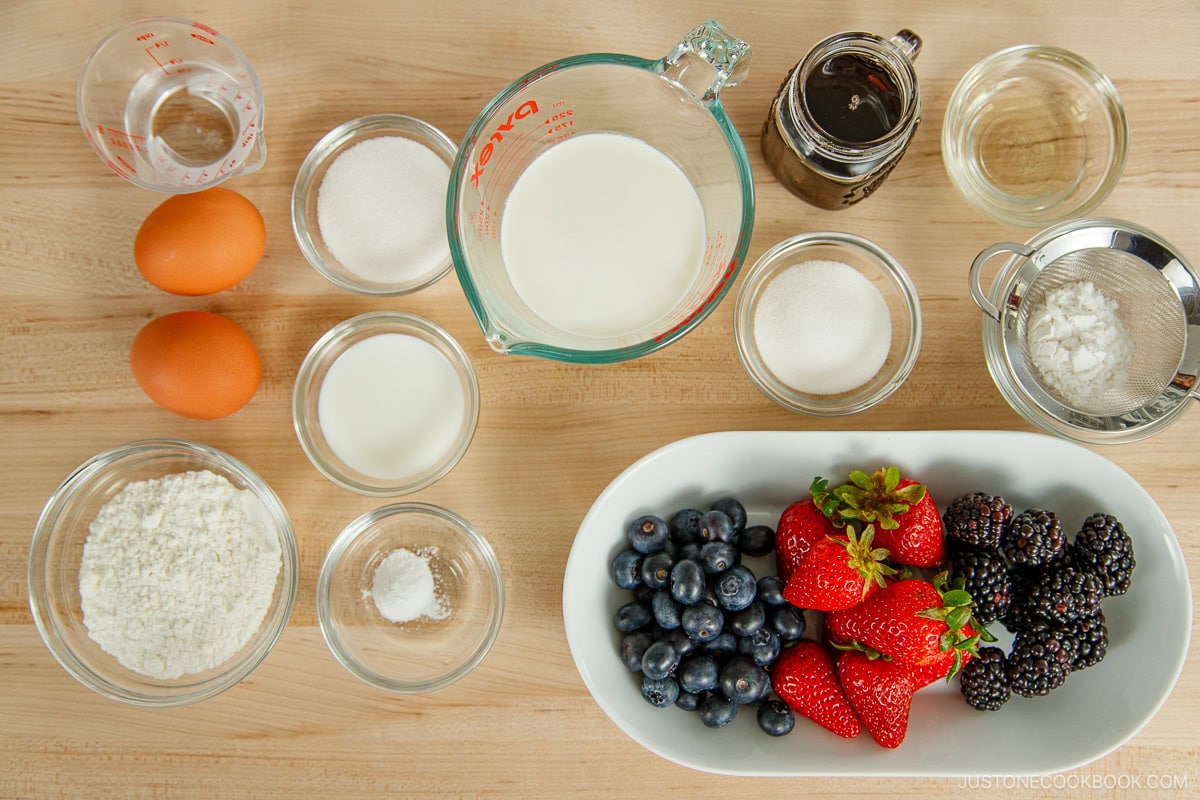
- I highly recommend to mix and cook only one batch of batter at a time, even if you double or triple the recipe. Otherwise, the batter will deflate if left to sit for too long. To make two or more servings, you will need multiple nonstick frying pans on the stove. Alternatively, you can use an electric or cast iron griddle with a lid.
To Make the Fresh Whipped Cream (optional)
- If you‘d like to serve the Fluffy Japanese Soufflé Pancakes with optional fresh whipped cream, make it now. First, prepare an ice bath: Put ice cubes and water in a large bowl and place a clean and dry medium bowl on top of the ice water. Add ½ cup heavy (whipping) cream and 1½ Tbsp sugar to the medium bowl to keep them cold.
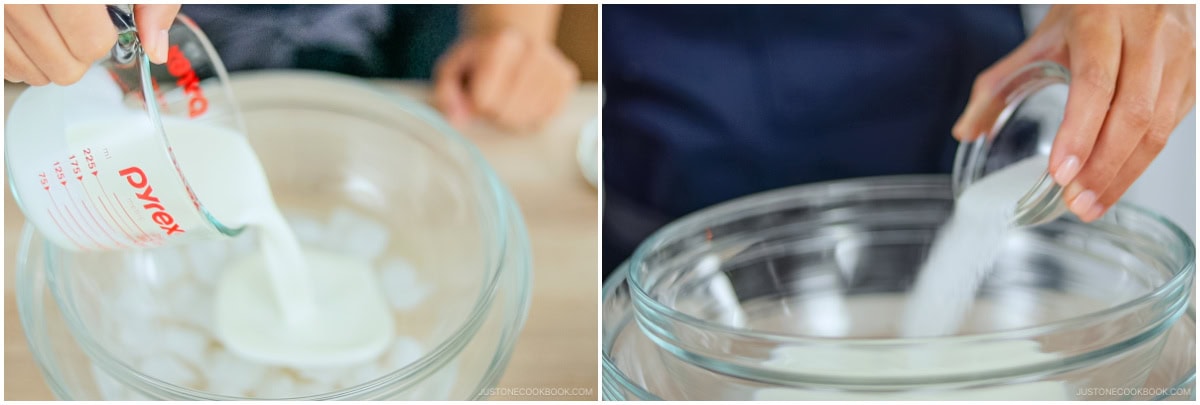
- Whisk on high speed until medium to firm peaks form. The cream should not be runny but soft, fluffy, and firm instead. Keep the whipped cream chilled until you‘re ready to serve the pancakes.
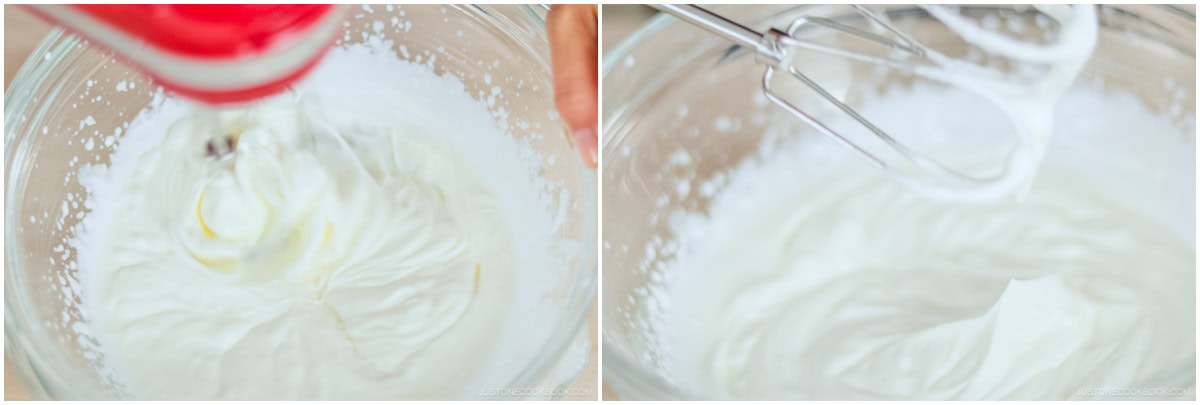
To Mix the Batter
- Separate 2 large eggs (50 g each w/o shell) into whites and yolks in two different bowls. Put the bowl with the egg whites in the freezer for 15 minutes. Why do we partially freeze the egg whites? Please read why in my post 2 Tips to Make Perfect Meringue (Egg Whites).
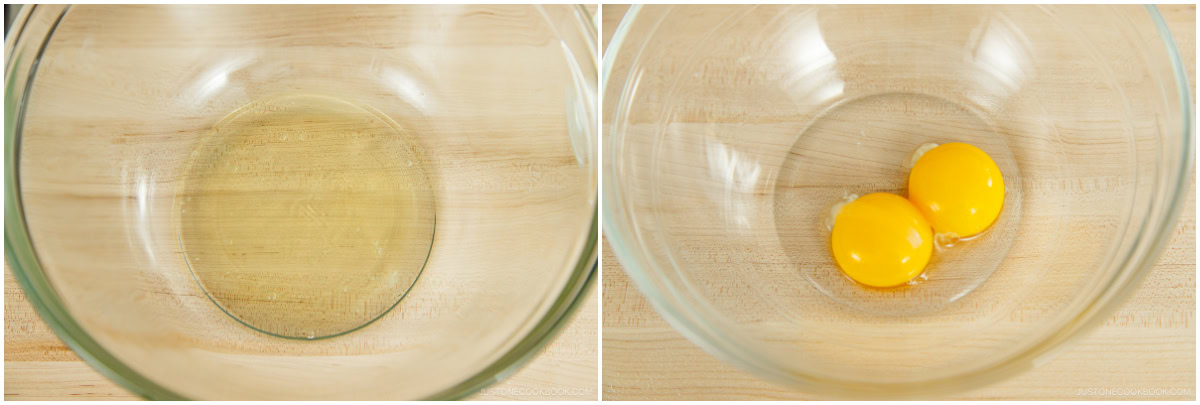
- In the meantime, add 1½ Tbsp whole milk and ¼ tsp pure vanilla extract to the egg yolks and whisk using a hand whisk until thick and frothy.
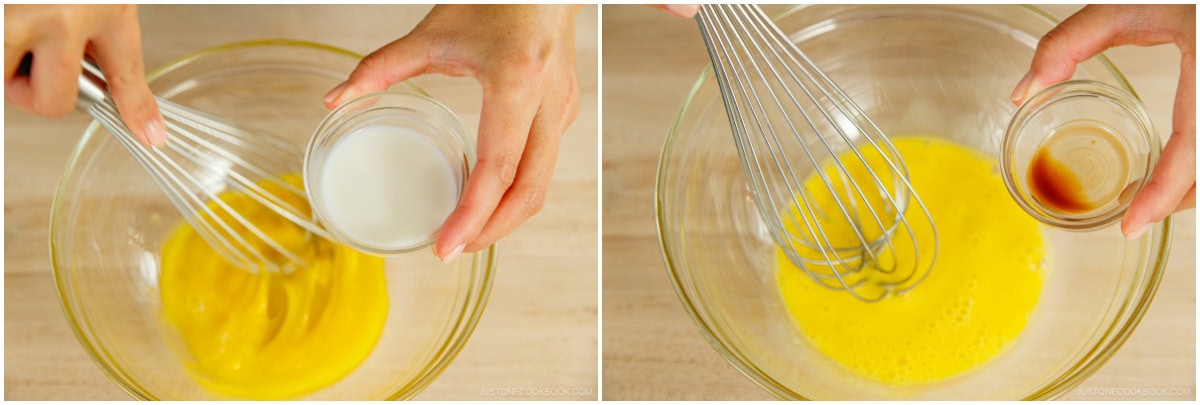
- Sift ¼ cup cake flour and ½ tsp baking powder into the bowl.
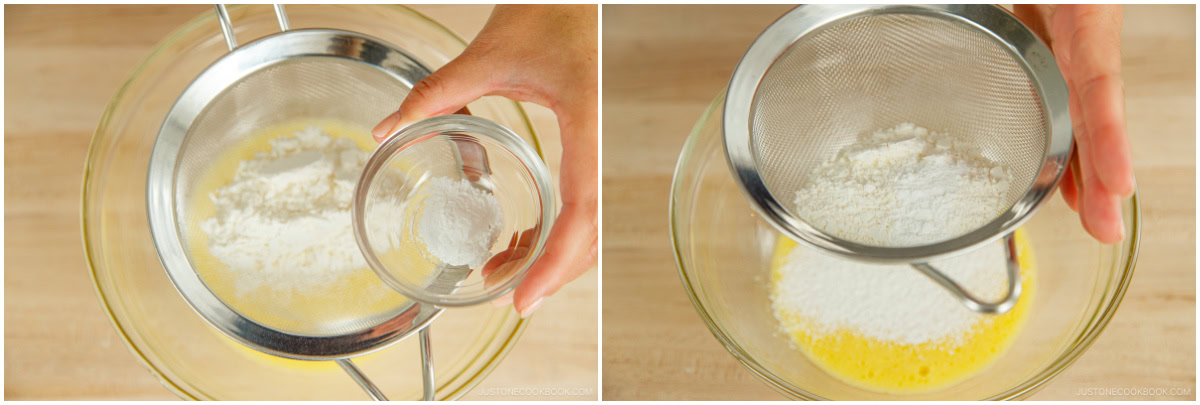
- Whisk to combine thoroughly; do not overmix. Set aside while you make the meringue.
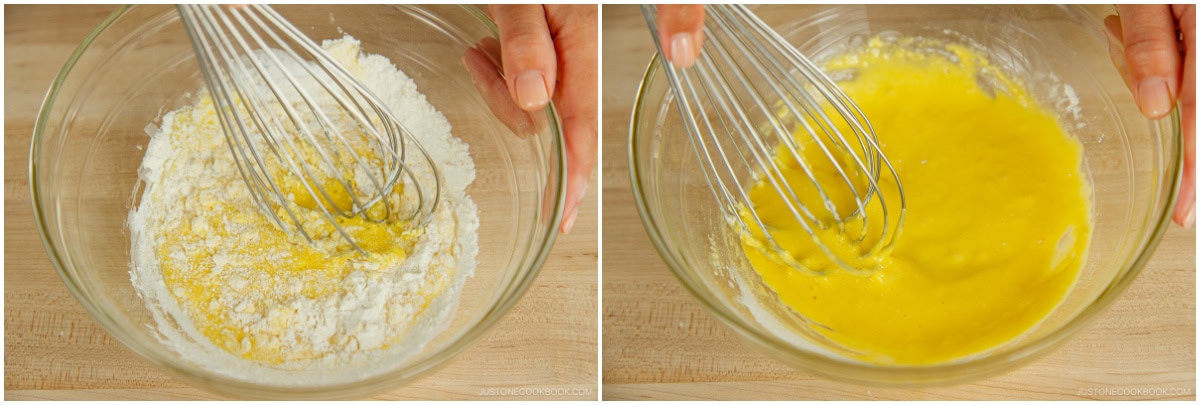
To Make the Meringue
- After 15 minutes, take out the bowl with the egg whites from the freezer. The egg whites should be half frozen. Now, start beating the egg whites with a hand mixer (you can also use a stand mixer or balloon whisk).
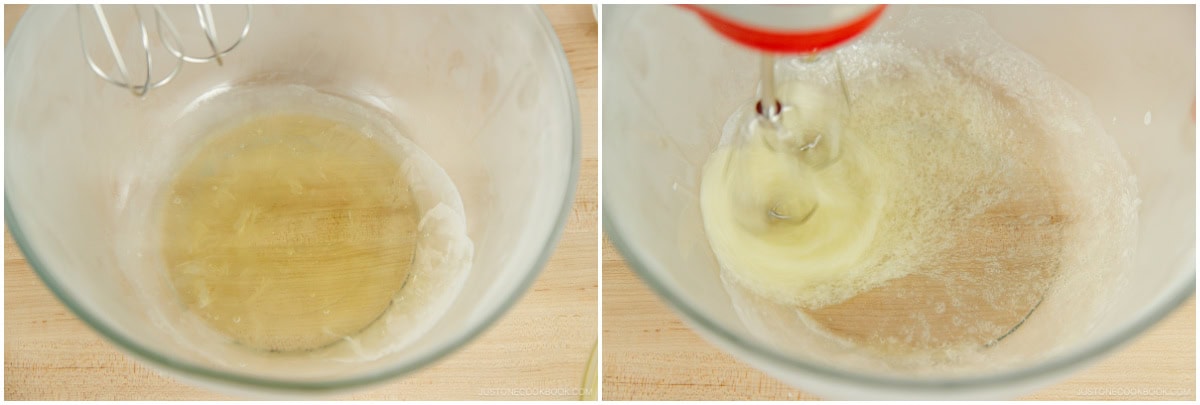
- When the egg whites turn frothy and opaque, gradually add in 2 Tbsp sugar, roughly one-third of it at a time. Then, increase the mixer speed to high (Speed 10) and beat vigorously until stiff peaks form (see the next step for how to check). It takes about 2 minutes of beating at high speed to reach stiff peaks. Tip: When using a stand mixer, I usually pause beating when the meringue is almost done. Take off the whisk attachment from the mixer and use it to hand-mix the looser egg whites near the bowl's edge into the stiffer whites near the center until it's all homogenous in texture. Then, put the whisk back on and continue beating.
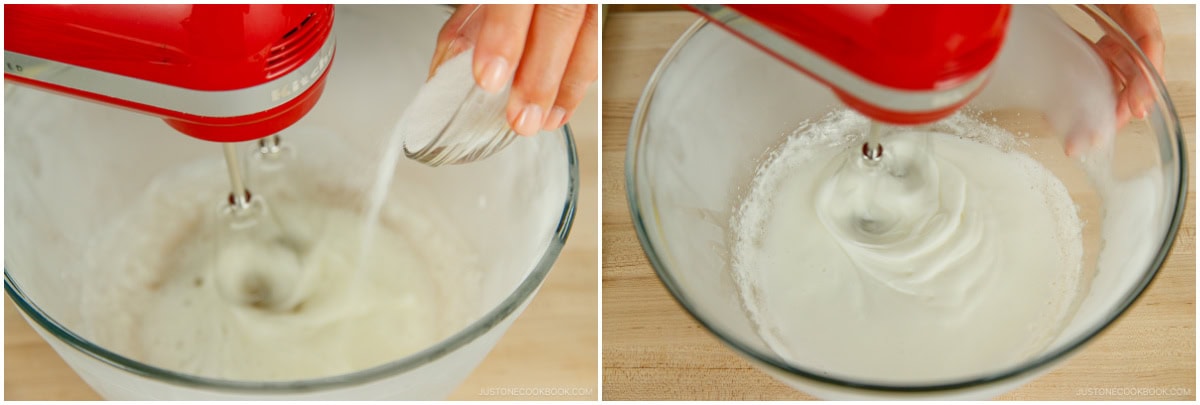
- To check for stiff peaks, stop whisking and pull up your beaters or whisk. The meringue in the bowl or on the whisk should be firm enough to hold a peak, pointing straight up (or maybe folding over a little bit just at the very tips). By this time, the meringue should have a glossy texture, too. Tip: If you overbeat the meringue, it will become very stiff and grainy and won't incorporate into the batter at all.
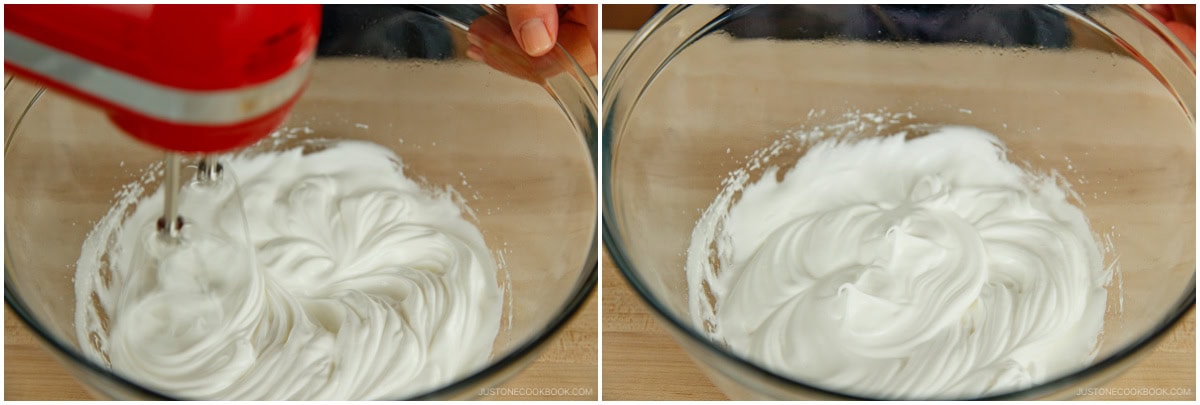
- Heat a large nonstick frying pan to 300ºF (150ºC) over the lowest heat. Brush with 1 Tbsp neutral oil and lightly remove any visible oil with a paper towel (otherwise the pancakes will have a spotty pattern). Keep the pan on low heat while you fold in the egg white meringue into the egg yolk mixture in the next step.
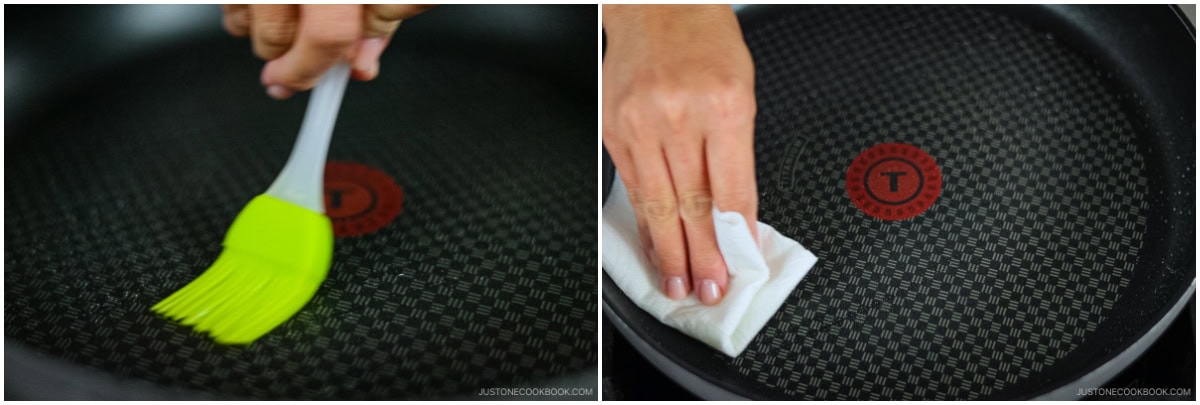
To Fold In the Meringue
- Take one-third of the egg white meringue and add to the egg yolk mixture. Whisk together by hand (don’t worry too much about breaking air bubbles at this point).
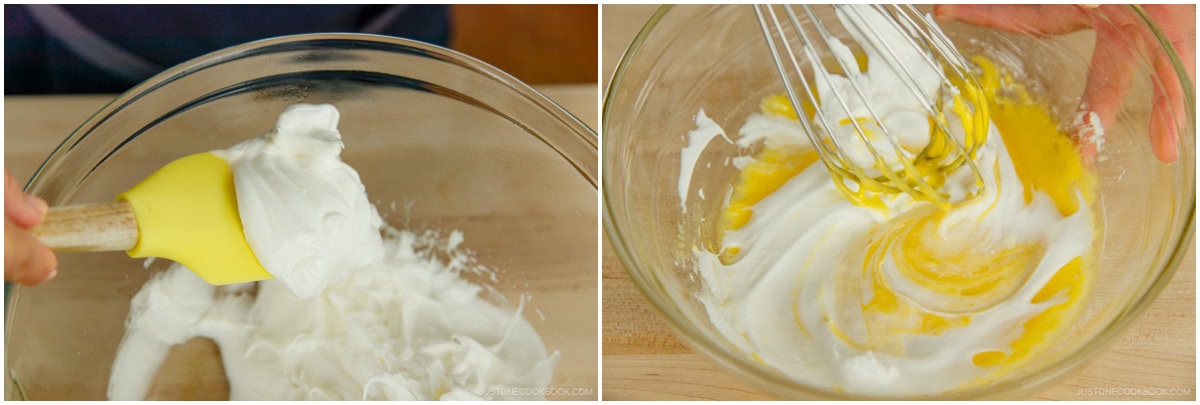
- Next, take half of the remaining meringue and add to the egg yolk mixture. Using a hand whisk, gently fold them in without breaking the air bubbles in the egg whites. Why do we use a whisk instead of a silicone spatula? Please read my post 2 Tips to Make Perfect Meringue (Egg Whites).
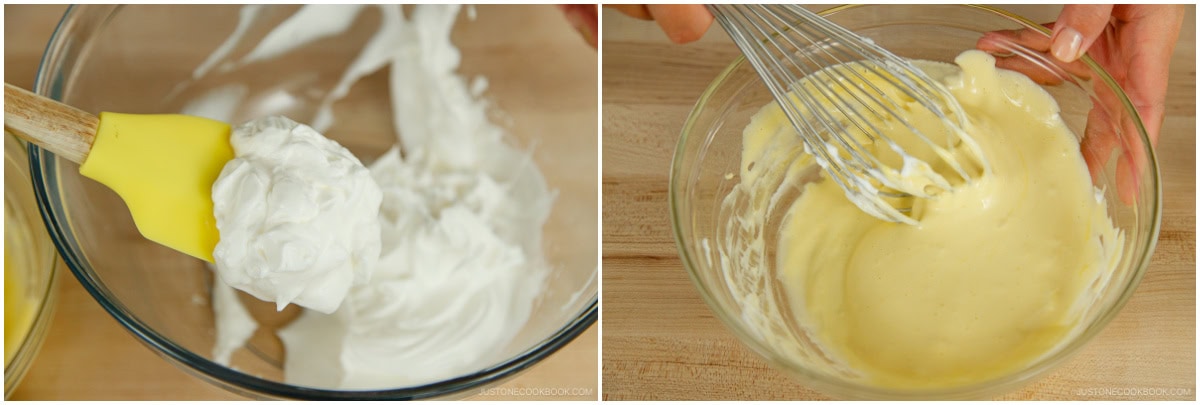
- Now, transfer the egg yolk mixture back into the bowl with the remaining meringue. Very gently fold the two mixtures together, taking care not to deflate the air bubbles in the meringue and batter as you fold. Mix the batter very gently until well combined and homogenous.
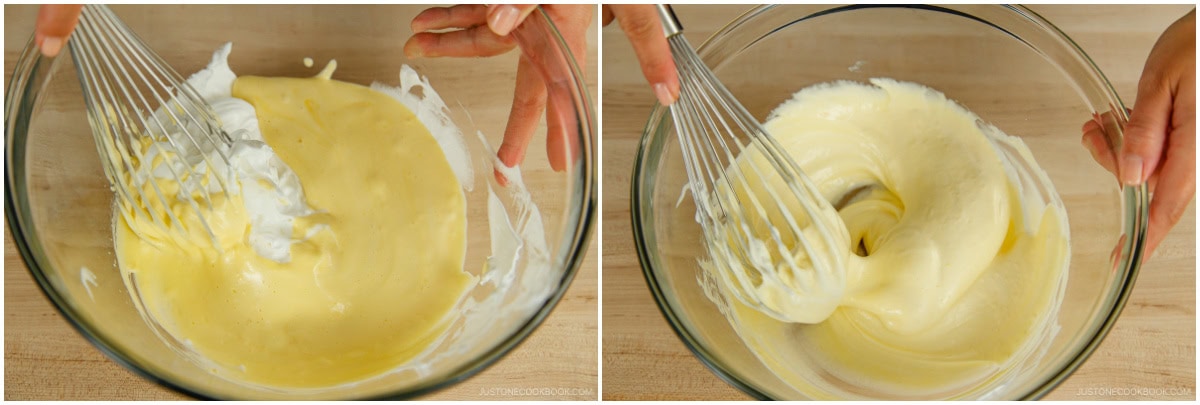
To Cook the Pancakes
- Keep your nonstick frying pan heated to 300ºF (150ºC) at all times over low heat. Remember, each pancake gets roughly four small scoops of batter, and you will be making three pancakes. For the first pancake, place one scoop of batter and make a tall mound in the frying pan, using a small ladle or a serving spoon (that’s bigger than a regular spoon—probably 2–3 Tbsp). Next, stack one more scoop of batter onto the first scoop already in the pan. Repeat for the next two pancakes, giving each pancake two scoops of batter.
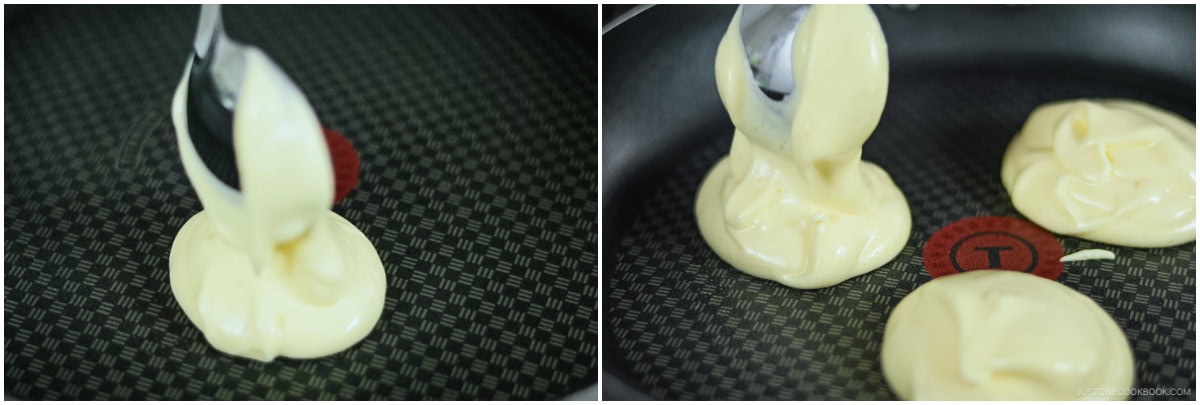
- By the time all three pancakes have two scoops, the surface of the batter is slightly dry already. At this point, you can mound one more scoop on top of each pancake, keeping the batter piled up high. In the bowl, you should still have roughly three scoops left (if you have slightly more, that’s okay).
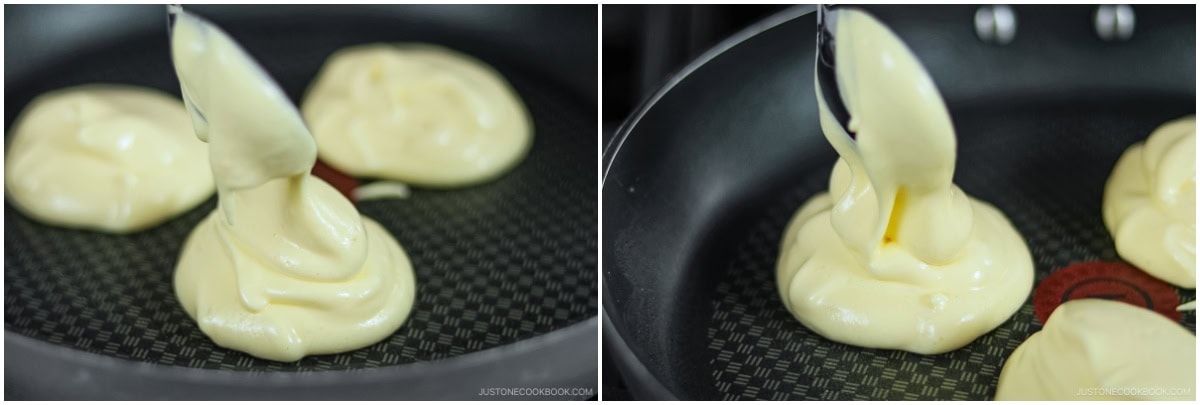
- Set the timer for 6–7 minutes and add 1 Tbsp of the 2 Tbsp water in three empty spaces inside the pan. Cover with a lid. The steam from the water keeps the pancakes moist while they cook. Please note: The suggested time is just a guideline; how long you will cook the pancakes is based on the temperature of your frying pan.
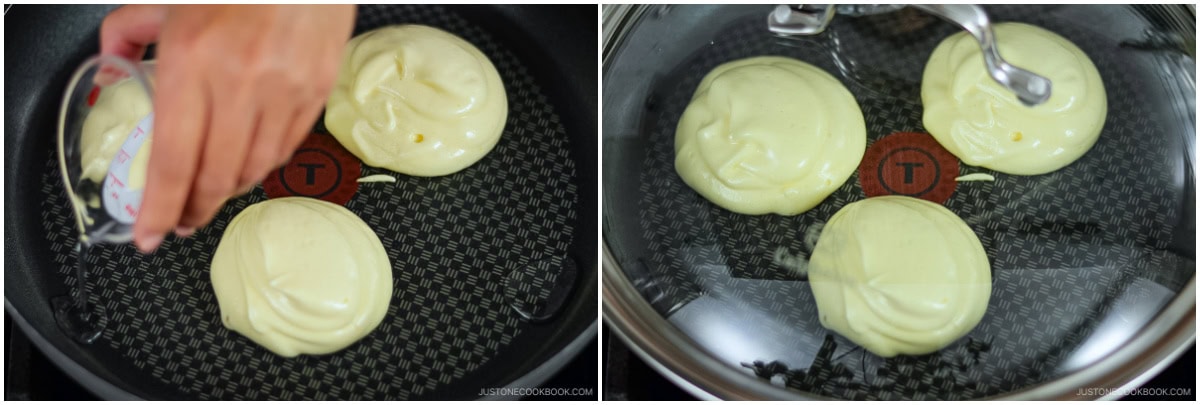
- After 2 minutes have passed, open the lid, and add one final scoop of batter to each pancake (or more scoops if you have more batter). Make sure to stack the batter high, not wide. If the water has evaporated, add a little bit more. Cover with the lid and cook.
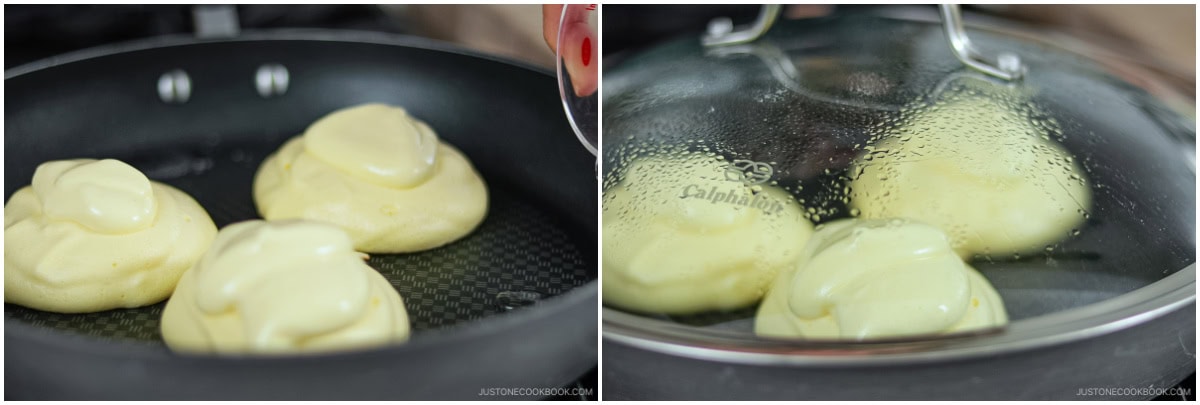
- After 6–7 minutes have passed, lift the pancake VERY GENTLY using an offset spatula. If the pancake is stuck, don’t touch it until it firms up a little. If you force it, the pancake will crack in the middle. When the pancake is ready, you can easily move the pancake. Repeat with the other pancakes.
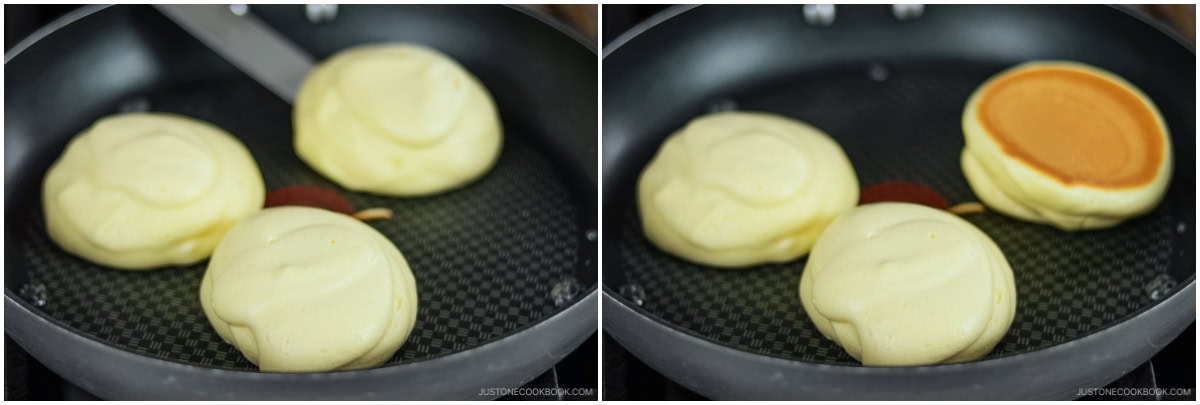
- Here is another set of images to show the process. Slightly pull the pancake to create an empty space and gently flip it over with a “rolling over” motion.
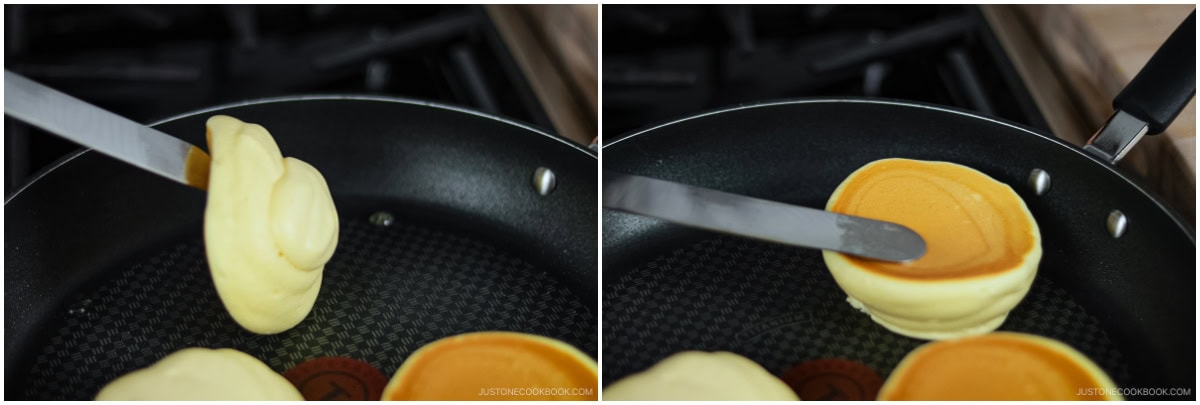
- Add another 1 Tbsp water to the empty spaces in the pan and cover. Set the timer for 4–5 minutes to cook the other side on the lowest heat setting.
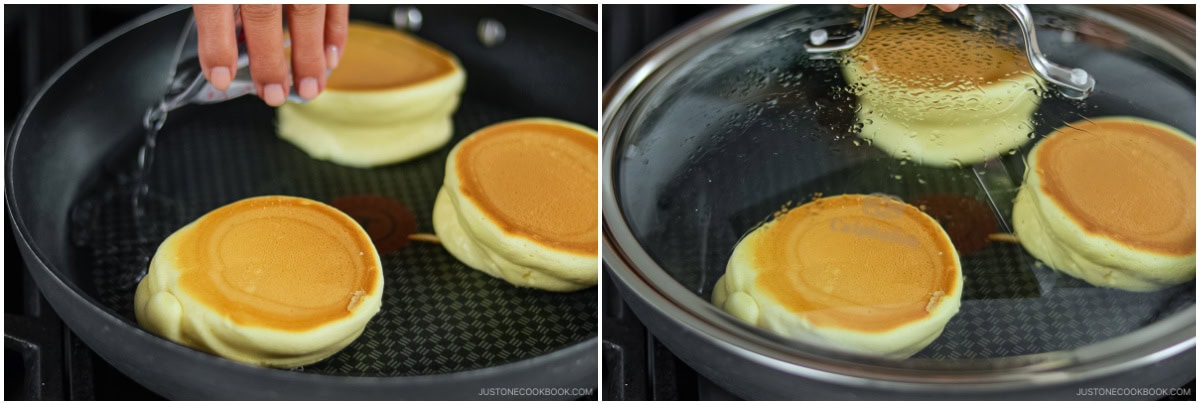
- Once they are nicely browned, transfer the pancakes to your serving plates.
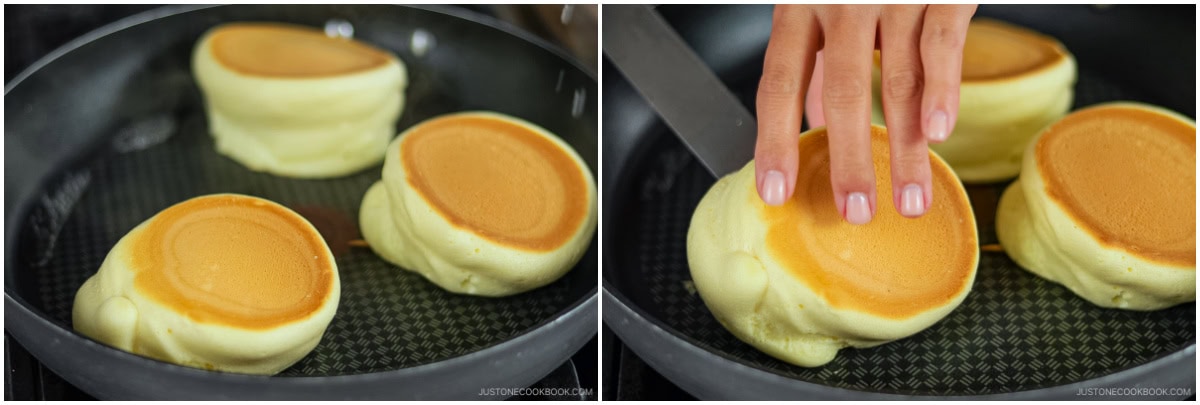
To Serve
- Place the optional fresh whipped cream on the pancakes and top with fresh berries. Dust your Fluffy Japanese Soufflé Pancakes with 1 Tbsp confectioners’ sugar and drizzle with maple syrup. Enjoy!

To Store
- For the fluffiest texture, I recommend making these soufflé pancakes just before serving. If you have leftovers, transfer them to an airtight container and store in the refrigerator for up to 2 days.
Notes
- Soufflé pancakes can be tricky to make (probably not easy for a beginner cook), so make sure to read my tips in the post thoroughly before you start cooking.
- Beat your egg whites correctly. Underbeating or overbeating will cause the pancakes to deflate after cooking.
- Cook over low heat, and make sure the insides of the pancakes are properly cooked through. If the inside is not cooked through, there is no structure to hold up the pancakes and they will collapse as soon as the temperature drops.
Equipment
Nutrition
Editor’s Note: This post was originally published on May 12, 2018. It was republished on November 10, 2024, with more helpful cooking tips and information.
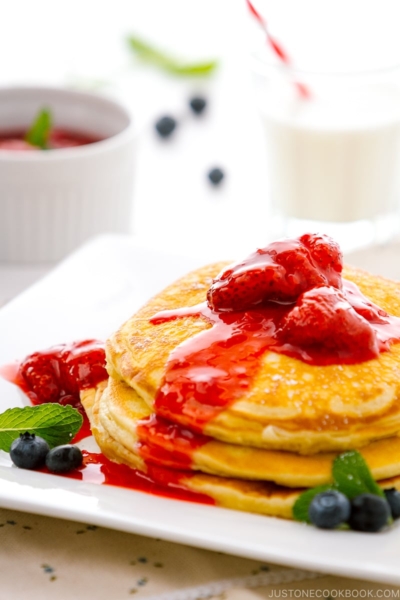
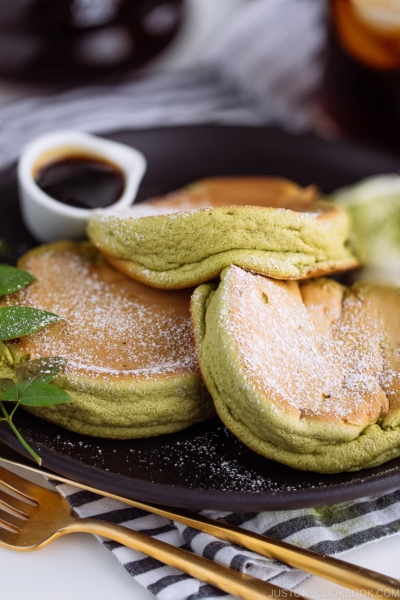
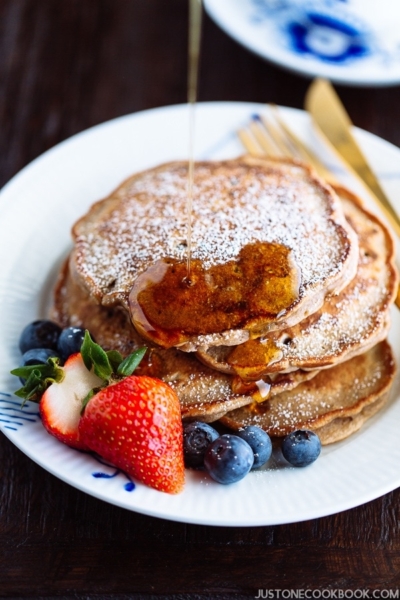
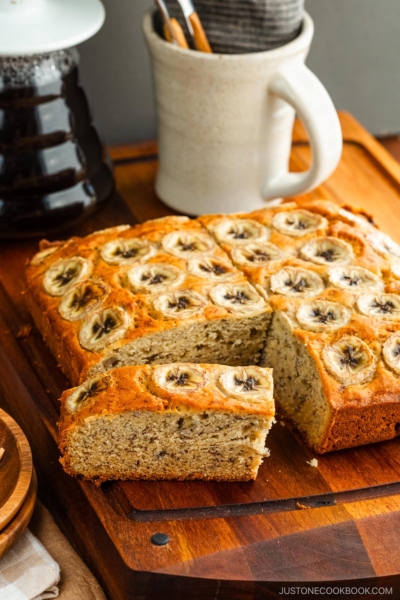




Delicious! It’s a new favorite for the family
Hello, Maryna! Thank you for trying Nami’s recipe and sharing your beautiful pancake photo! Looks so delicious! 🤩
Where are the amount of ingredients we need
Ahh- I think I’m going to love seeing these pancake rise.lol
Hi Agnes! Haha enjoy seeing the pancakes rising! 😀
These souffle pancakes look delicious! I really liked them! But you know what I like even more? Alll your step-by-step recipes (with lot of pictures)! It’s one of these little details that make your blog so special and still makes me read your recipes (all of them) through the years!
Cheers from Brazil!
Thank you!!! Thank you so much for your kind words. Many JOC readers have spoken about the step by step pictures and for the past 7+ years, I get a lot of positive feedback on them. One point we almost gave up taking step by step pictures (as they are time consuming), but we just couldn’t make up our mind as so many of you would be disappointed. Glad we didn’t give up. 🙂 Thank you again!!
I’ve tried making those soufflé pancake once; but it was always gooey on the inside and a bit too overcooked on the outside… I guess that’s because my pan was too hot. Otherwise the recipe was almost the same except for the water tip. I’ll try it again following that.
Now a funny story about how I discovered the soufflé pancake:
In Japan, Sendai more exactly, there’s a restaurant called Ball Park that is specialised in making those pancakes…,I decided to go there with a friend because the baseball players from the team Rakuten Eagles, often go there to eat, and always talk about the delicious pancakes. So as a fan, it’s a place to go XD
Anyway, the day we decided to go with amy friend to taste them, we entered and we got the chance to have two of the baseball players eating there (one of them is a first string pitcher and we love this brat a lot). When the waitress gave us a table, we got the one right behind them… Needless to say that I was unable to remember the taste and texture of the pancake, because I kept looking at the player behind my friend, and facing me. I was too nervous and excited !! Ahah.
That’s a good memory I got from Japan and fluffy pancackes, and same goes for my friend. So I can’t wait to try to cook her those pancakes 😀
Ah also, I forgot to ask, if I wanna make matcha pancakes, what’s the quantity you recommend to have a nice color and taste ? Would 1tbs of matcha powder mixed in the cake flour be enough ?
Hi Andrea! Yeah if the inside is gooey and more raw, probably your heat was too high at starting point. Cook slow, covered, and steam is option (as I mentioned in the post, it didn’t seem to matter much). 🙂
Wow thank you so much for sharing your story of your first Souffle Pancake WITH the baseball players! I for sure won’t remember about what I ate if I were in your situation. But that’s such a cool memory to keep!! For the matcha version… hmm 1 Tbsp should be plenty. Try from 2 tsp and decide on additional 1 tsp (total will be 1 Tbsp)?
It’s funny how many memories I have involve food. I guess the taste/smell/visual and other things like this makes a memory easier to remember.
Ok thank you, i’ll try with 2 tsp as a starter and see if it’s enough.
I am just like you. I remember things very well especially around the food… 😀
Hi Nami!,
in a few weeks we will travel to Japan from Spain. Our first trip to Japan. Among the many visits we have planned we think that delicious pancakes souffle are a must-try as you say.
Now, in addition, thanks to your recipe we will also enjoy them at home!
Thank you very much!
Hi Rafael! You’re going to Japan for the first time! How exciting! Yes, visit one in Japan and then you can make these once you return! Have a wonderful trip!
I like this recipe as I’ve been waiting for it, the pancake is Look so amazing , my daughter love it with dragon fruit and my nephew was asking for more
Hi Somkith! Thank you so much for waiting! Hope you and your family will enjoy this recipe! 🙂
Can I use baking soda instead of baking powder?
Hi Maria! I’m not familiar with it, but here’s what Bonappetit says: https://www.bonappetit.com/test-kitchen/cooking-tips/article/baking-soda
I am so happy that you made this recipe. I can’t wait to try it out! Thank you for sharing!
Hi Kristin! I hope you enjoy this recipe! 🙂
I would like to make this gurgies one as fast as possible . But Can I use all purpose flour instead of cake flour ? Since I can’t find cake flour easily in my country.
Hi Sara! I had never tried and compared the two pancakes side by side made with all-purpose flour and cake flour. But in Japan, we do use cake flour for Souffle Pancakes. Probably not the ideal for the recipe, but you should be able to make it. Or you can make cake flour easily with corn starch.
https://www.thespruceeats.com/how-to-make-cake-flour-p2-3057755
I live soufflé pancakes! I have searched for this recipe before on your site andso happy you finally have one posted! Thank you! Can’t wait to try.
Hi Mydao! Hope you enjoy this recipe! Thank you so much for waiting. 🙂
Thank you so much for posting the video. Actually, because of the bad weather my husband decided to skip some extra work and we are planning to make souffle pancakes using this recipe. Wish us luck! 🙂
If possible in the future please upload a Japanese style French toast recipe, it is so yummy! All the best!
Hi Kornelia! Ohhh! How did your first try go? Hope you enjoy the pancakes. I’ll add your request to my list. But is there any particular style you’re talking about? I follow my mom’s method (she only cooks in Japan), but I don’t know if they are different from American/Western style… what makes it Japanese-style to you?
Thank you for the reply! 🙂
The pancakes were delicious and so ふわふわ! Of course they weren’t perfect this first time because I have to adjust the cooking time considering my stove which is a bit older and doesn’t have a proper low setting, so they came out a bit dark but not burned . Next time they will be perfect!
Actually I have never been to the States, the closest I got was Canada, but in Europe French Toast isn’t as moist and tender as in Japan. I have been experimenting with it using frozen bread or fresh butter bread, or adjusting soaking time… I wonder how to get the soft moist Japanese Cafe style toast and how to serve it!
Hi Kornelia! Thank you so much for trying the recipe! Glad to hear you liked it. Yeah, it took me several tries to understand my stove and timing. Once you know your own setting, write down in your note, and you’re all set! You can make perfect pancakes as long as using the same pan and stove! As for the French toast, Japanese toast bread plays an important role in texture of French toast. Very different from American toasts (dry and not moist at all)… I assume European toasts are similar to Japanese (considering Japan gets more European influence…?)…
I was confused with the stove temperature set at the lowest setting or 300 degrees Fahrenheit. The lowest setting on my gas stove was 212 degrees Fahrenheit. Through trial and error the temperature should be at 300 degrees Fahrenheit which is medium on my stove. Please clarify the temperature. Thank you!
Hi Al! Every stove is different and there is no specific temperature for “low” or “medium” etc. So you need to learn how to use your stove to adjust. With the lowest setting, the entire frying pan will slowly heat up (instead of only one spot that gets hot). 🙂
The bread makes a bigger difference in fluffiness of French toast than the egg/milk/soaking time variables. Try making french toast with brioche type bread… It’s amazing (disclaimer: I don’t think I’ve ever had Japanese style french toast, and I know I’ve never used Japanese shokupan for it because why “waste” it on that when my favorite thing ever is with toasted with butter and honey and it’s hard to get here so I have to make my own which happens approximately never, but I could see shokupan also giving a soft texture to the French toast)
Just made these delicious bits of yumminess for my daughter’s birthday breakfast. We followed the recipe exactly (thanks for the great pictures) and they were perfect. I even used my infrared thermometer to check the pan temp. We added a drizzle of Nutella sauce ( 1 tablespoon Justin’s chocolate hazelnut and 2 tbs heavy cream and heated in microwave for 15 seconds to blend, then more cream added to get the right consistency) because…birthday! And we are cooking at about 2000 meters elevation in case any high altitude readers want to try. Thank you!!
Hi Karrie! Happy Belated Birthday to your daughter! I’m so happy this recipe of mine made her day a bit brighter! Thanks for trying my recipe! The Nutella sauce… that sounds so delicious. She is a lucky girl! Thanks for the information on higher elevation cooking too. 🙂
I haven’t made these yet but I was wondering if I can add things like chocolate chips or blueberries into the batter or will that effect the fluffiness
Hi Lena! I haven’t tried adding chocolate chips, blueberries, or anything that’s heavy in the pancake batter before. It’s a bit difficult pancake recipe to start, so I might recommend making this as it is first until you learn about your heat (it’s very hard to control the heat depending on your frying pan material, etc) and beating meringue correctly. 🙂
Looks so delicious! My daughter and I will make it this weekend.
Hi Claire! Hope you and your daughter will enjoy making these pancakes! 🙂
Thank you Nami san for sharing yet another great recipe! I have made pancakes many times but certainly not a souffle pancake and will certainly try. I can see similarities with making a souffle cheese cake in that you whip the egg whites separately and folding them gently into the egg yolk batter and not forgetting water that is required to steam the entire pancake batter whilst frying in the pan. Can’t wait to try it and perhaps I will upload some photos later via instagram later. Thanks again for sharing this simple and delicious recipe!
Hi Francis! I hope you enjoy these souffle pancakes. They take more time and effort than regular pancakes, but just consider they are in different category. LOL. I think this is much similar to Souffle than Souffle Cheesecake in terms of texture. Hope you like it. I look forward to seeing your picture – just don’t forget #justonecookbook, as I may miss @justonecookbook when I get too many notification at once. 🙂
Hi!
What are the differences between a Japanese cheesecake and pancake? Usually the Japanese pancake doesn’t have cream cheese, right?
Hi Pedro,
Japanese pancake doesn’t have cream cheese and a totally different flavor from Cheesecake, but this fluffy pancake has a souffle texture like a Japanese Cheesecake. Here is a recipe for Souffle Japanese Cheesecake: https://www.justonecookbook.com/souffle-japanese-cheesecake/
We hope this helps!
Thanks for sharing this recipe, Nami! I’m just wondering if anybody knows any local shops that serve these fluffy japanese pancakes, particularly in the Bay Area. I’ve been searching yelp and google but haven’t found one yet..
Hi Marigold! As far as I know, I haven’t seen any Japanese restaurants serving this type of pancakes in the Bay Area… probably not enough Japanese populations? Maybe LA may have it? I’m not too sure… it will be super popular for sure! 🙂
Just had one in a cute little shop in Millbrae, Ca. It was light, tall and jiggly delicious. The shop is called Uni Soufflé.
Thanks Shirley! Will try that this weekend! 😊 And Nami, some of us are really hoping you open up your own restaurant! 🙏🏼 Seriously! ❤️
Thank you, Marigold! I rather want to be a customer who enjoys good food. 😀
Hi Shirley! Thanks for sharing! Maybe I’ll try it one day when I’m visiting the city. 🙂
There is a great place in stonestown mall in San Francisco.
Thank you so much for the incredible recipe for these japanese souffle pancackes!
I mad them for my father, who could not eat, because he got 4 of his frontteeth out. After I made him these pancakes, he was so thankfull and ate them deliciously. He was realy in love with them. Thanks again!! ^^
Hi Ssemi! Thank you for your kind words! I’m happy to hear that your father enjoyed this recipe! 🙂
Thanks Nami for sharing your passion of cooking with love for your loved ones.
You are making many people less stress and dare to try new recipes. Bless your heart ????
Hi Linda! I’m so happy to hear that you enjoy my recipes and thank you so much for your kind words. 🙂
My egg yolk batter came out very thick and paste like after adding the flour, nothing like yours in the picture or video.
What went wrong?
Hi Julie! Did you use a kitchen scale to measure the flour? Typically, when you scoop the flour, 1 cup ends up like 150 g instead of the correct 120 g. Which makes the mixture really thick and dry (this recipe requires 1/4 cup but I’m using it as an example). If you use a cup measurement, there is a right way to do it:
It’s really important that you measure the amount correctly. Since you said “very thick” that was my first thought. 🙂
Nami! My souffle pancake tasted great but I saw it flatten/deflate as I opened the lid at the end :(. Any tips? Open lid slower?
Hi Lily! Hmmm, it’s hard to tell what went wrong with just one comment (and not seeing how you cook it), but my first thought was your egg whites were not beaten correctly so the air got deflated (no good structure inside the pancake). It should hold up even though you open the lid when you have a good structure. Also, make sure it’s cooked through inside. Just because the pancakes are turned nicely golden brown, it doesn’t mean it’s cooked inside. 🙂
Hello! Thank you for posting, I tried making this at home and the pancakes came out lovely. My only concern was the slightly eggy taste from the pancakes after they were cooking. Is there any tip for minimizing that egg taste?
Hi Michelle! Thanks so much for trying this recipe! So glad your pancakes came out well. Souffle pancakes are made of eggs, really, so it’s hard to erase the taste. However, you can add more vanilla to minimize/distract the egg taste. 🙂
Hi! Just wondering if we have to use cake flour, or if all purpose would be okay for the recipe outcome?
Thank you!
Hi Emily! I recommend using cake flour for the best light texture. However, with this current situation, if that’s what you have right now, I think it’s okay.
Cake flour can be substituted by doing the following with AP Flour: measure out 1 cup AP Flour remove 2 tbsp and add 2 tbsp corn starch.
Can I just double the ingredients to make six pancakes at once
Hi Raymond! Sorry for my late response. If you can cook all 6 pancakes (in one skillet with a lid OR 2 frying pan with lids), then sure! Otherwise, you have to make it in batches as the air bubbles in the meringue will deflate before you start cooking. 🙂
I love this recipe! So delicious! I have made this 3 times, me and my family love it!
Hi Ella! I’m so happy to hear that your family enjoyed this recipe! Thank you for your kind feedback. xo
Thank you so much for this recipe! I’ll have to try it soon. I had these at A Happy Pancake in Omotesando and loved them!!!
Hi Drisdy! I’m so happy to hear you liked the souffle pancake! Hope you enjoy this homemade version. 🙂
I tried making these yesterday with a different recipe and this morning when I did it using this recipe (for my mom) there was a huge difference. This recipe was less sweet which I preferred for breakfast and it was fluffier which I loved. Thank you for sharing this. I can’t wait to try other recipes up here.
Hi Lexy! I’m so happy to hear that. Thanks so much for trying my recipe. I’m glad you liked it. 🙂
hi, can i use semi skimmed milk instead of whole milk?
Hi Neve! Yes, I think you can use that. 🙂
I’m so happy to see this recipe posted! It has always been my favorite.
Hi Thom! Thank you for patiently waiting! I hope you enjoy this recipe and my tips shared in the post are helpful. 🙂
Hey there, I am currently cooking these pancakes! After 6 minutes, they were not easily flippable and I scuffed up the bottom of the pancake when flipping. My suspicion is that my pan wasn’t hot enough to cook them, even at low heat. For next time, how can I test the heat of my pan without a thermometer?
Hi Kit! First of all, it’s important to start heating up the pan way ahead of time before you start cooking (preheat). You can’t use higher heat to heat up because it has hot spot and certain spots get too hot. So you have to use low heat to slowly bring the entire pan hot. When you put the pancake batter, the temperature of the pan will drop but if you do preheat well, it should not go down much. You can’t use strong heat, because the problem will be the pancake surface will turn brown too fast while your pancake is not cooked through. By the time you take out, the pancakes will collapse because the inside has no structure yet. Therefore, it’s almost safer to slowly cook the pancake than heating up too fast. Every frying pan conducts heat differently, and so as stove heat is different for everyone… so it’s hard to tell how long it takes to cook. So I think the first trial is to learn about your pan and heat. 🙂
I am not sure why but my pancakes ended up having a very strong taste of eggs… the texture, look, and overall formation was great! Though I couldn’t help tasting eggs :(( though loved the recipie, and I am sure it was a mistake from my end !
Hi Diya! Souffle pancakes are made of mostly eggs… so that’s normal to have egg taste. If you don’t like the taste, you can cover up with more vanilla extract. 🙂
How long can i hold the batter? If i put them in the fridge over night Will it be still good result in the next morning?
Hi April! No, once you make the batter, you have to make it immediately while the air is in the egg whites. It’s like souffle, it’s all about the air in the meringue to rise the pancakes!
Recipe was great but when I tried flipping it was too raw so it fell apart;(
My husband still loved it and so delicious 😋. I’ll try and make it again! Thanks for recipe!
Hi Emma! Possibly your heat was too strong, so the surface turned brown and you felt you need to flip but inside was still not ready. Heat control is really important in this recipe. Make sure the pan is hot/optimal temperature when you pour the batter (so the temperature will go down) and cook slowly to make sure inside is cooked through and surface of the pancake is nice color. Once you get hang of it, it’s much easier! Good luck!
Anyone that made this found that after taken out of the pan they go down and are not as tall as in the pan? They were tasty but didn’t stay as fluffy as in the video or picture.
Hi Andrea! My first guess is that the inside of your pancakes was not cooked through so when the pancakes were inside and it was heated from the pan, it stays up (like hot air balloon). But as soon as you take out (removing the hot air), the pancake got deflated.
That’s because your pancakes were probably not done cooking. Don’t rely on brown color on the pancake surface because your heat could have been strong and finish cooking outside, but inside takes a long time to cook this type of pancakes. So focus on cooking inside (that’s why we need to cook low). When the pancakes have good structure inside, you can take out from the pan and it will stay up for at least 10-15 minutes (that’s when I can film or photograph these pancakes).
Good luck! Many people have succeeded, and I’m sure you can! Heat control and making good meringue are two important parts of this pancake recipe. 🙂
Made this and they tasted so good even though they were a bit over cooked maybe because I used an electric griddle? Will be making this again soon, need tips on the following:
-what’s the correct temperature setting if using an electric griddle? I shuffled back and forth between 120 and 170deg C
-my pancakes sat on the pan for more than 10mins and I had to lower the heat to avoid burning because the sides just wouldn’t cook, what’s wrong? I made flatter pancakes using the remaining batter and they turned out alright
-can this batter be transformed into a steamed/baked cake (in a square loaf pan)?
Hi, can I use yoghurt instead of milk?
Hi Tamara! To be honest, I’m not sure as I’ve never tried it with yogurt before… if you end up trying, please let us know how it went. 🙂
Hi Vivienne! Thank you for trying this recipe! I don’t think overcooking is due to the electric griddle. I feel it’s the most reliable and stable cooking device for souffle pancakes.
1. 300 ºF (150 ºC) all times. I use an infrared thermometer to keep checking and that’s the best I could control with a frying pan over the gas stove.
2. Was the pan preheated long enough that it was already 300 ºF (150 ºC) when you put the first round of batter? This recipe is really all about meringue and heat control…
3. Not sure as I haven’t attempted. Let us know if it works! 🙂
I have made it successfully just this morning using yogurt. No noticeable difference in taste or texture.
Hi Alex! Wonderful! Thank you so much for your kind feedback! 🙂